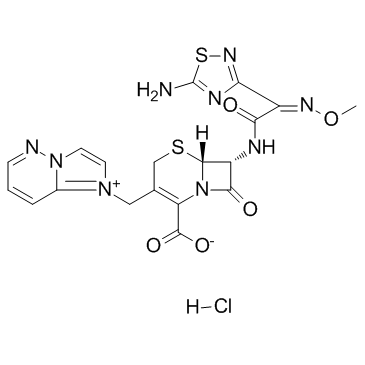Microbiology & Virology
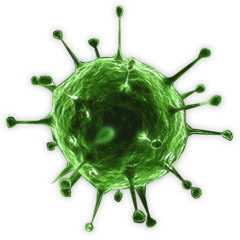
Microbiology & Virology
A virus is a small infectious agent that replicates inside living cells. Viruses cause many human diseases from small illnesses, like influenza, to more deadly diseases, like hepatitis B and HIV. Our body’s immune system defends against viral infection by generating specific antibodies to bind to and neutralize viral particles and by cell mediated immunity that destroys infected host cells.
Ziele für Microbiology & Virology
- Antibiotic(531)
- Bacterial lipoprotein targeting chaperone(1)
- CCR5(3)
- CMV(24)
- gp120/CD4(7)
- HBV(78)
- HCV(170)
- HIV(453)
- HSV(86)
- Influenza virus(139)
- NA(11)
- Reverse Transcriptase(67)
- RSV(38)
- SRPK(5)
- SARS-CoV(134)
- Antifungal(34)
- Orthopoxvirus(2)
- Antimalaria(10)
- Beta-Lactamase(0)
- VEEV(1)
- Arenavirus(10)
- Bacterial(1301)
- Enterovirus(21)
- Filovirus(5)
- Fungal(335)
- Parasite(387)
- Virus Protease(73)
- Chicken Pox & Shingles(0)
- Chikungunya(0)
- Coronaviruses(9)
- Dengue(2)
- DNA & RNA Polymerase Inhibitors(4)
- Ebola(0)
- Entry/Fusion Inhibitors(6)
- Epstein-Barr(0)
- Integrase Inhibitors(2)
- MERS(6)
- Others(0)
- Rhinoviruses(1)
- West Nile Virus(0)
- Yellow Fever(1)
- Zika(0)
- COVID-19(16)
- Antiviral(2)
Produkte für Microbiology & Virology
- Bestell-Nr. Artikelname Informationen
-
GC43031
C16 Galactosylceramide (d18:1/16:0)
C16 Galactosylceramide is a glycosphingolipid that contains a galactose moiety attached to a ceramide acylated with palmitic acid .

-
GC68449
CA inhibitor 1

-
GC66051
Cabotegravir sodium
Cabotegravir (GSK-1265744)-Natrium ist ein oral aktiver und lang wirkender HIV-Integrase-Inhibitor und Inhibitor des organischen Anionentransporters 1/3 (OAT1/OAT3) mit IC50-Werten von 2,5 nM, 0,41 μM und 0,81 μM fÜr HIVADA, OAT3 bzw. OAT1. Cabotegravir-Natrium wird hauptsÄchlich durch die Uridindiphosphat-Glucuronosyltransferase (UGT) 1A1 metabolisiert und hat ein geringes Potenzial fÜr Wechselwirkungen mit anderen antiretroviralen Arzneimitteln (ARVs). Cabotegravir-Natrium kann zur Erforschung von AIDS verwendet werden.

-
GC19085
Cadazolid
Cadazolid (ACT-179811) ist ein neues Oxazolidinon-Antibiotikum mit starker AktivitÄt gegen Clostridium difficile.
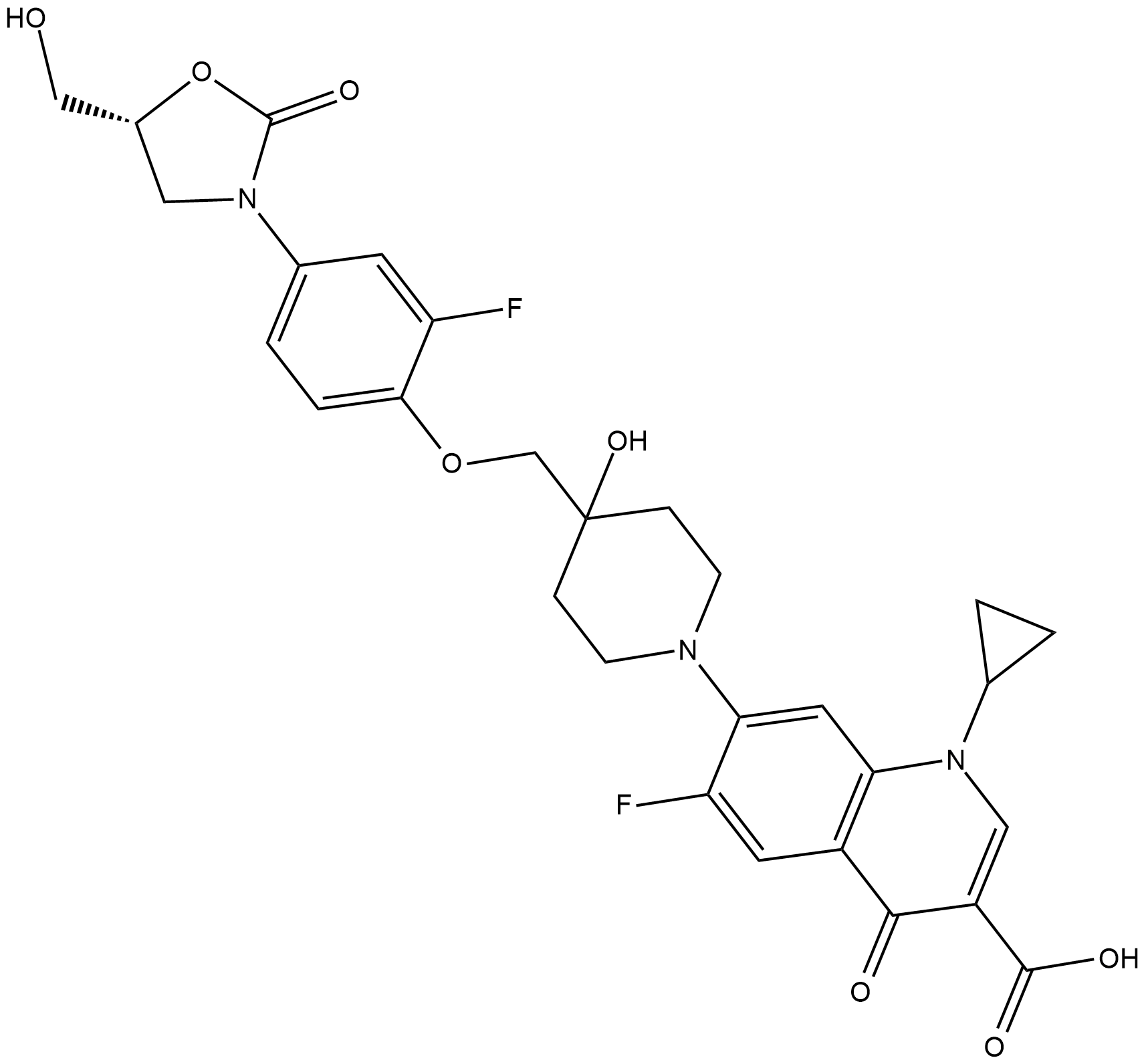
-
GC64102
Cadrofloxacin
Cadrofloxacin (Caderofloxacin; CS-940), ein oral wirksames Fluorchinolon, ist wirksam gegen aerobe/anaerobe grampositive und gramnegative Bakterien.
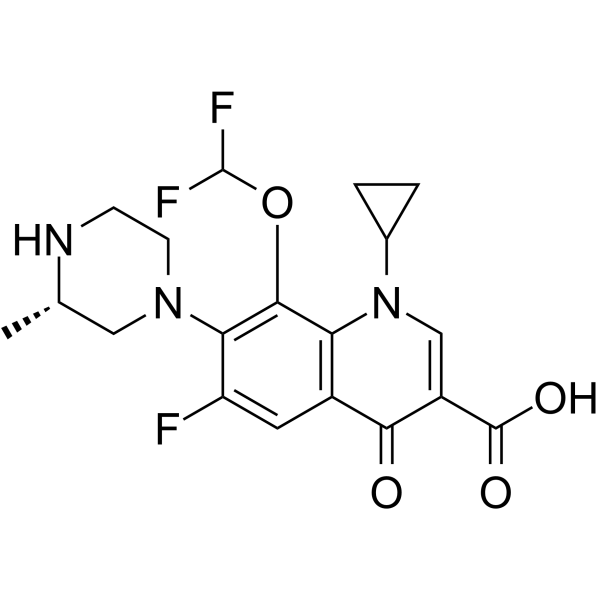
-
GC30960
Caerulomycin A (Cerulomycin)
Caerulomycin A (Cerulomycin) (Cerulomycin; Caerulomycin), ein Antimykotikum, induziert die Bildung von T-Zellen, verstÄrkt die TGF-β-Smad3-Proteinsignalisierung durch UnterdrÜckung der Interferon-&7#947;-induzierten STAT1-SignalÜbertragung.
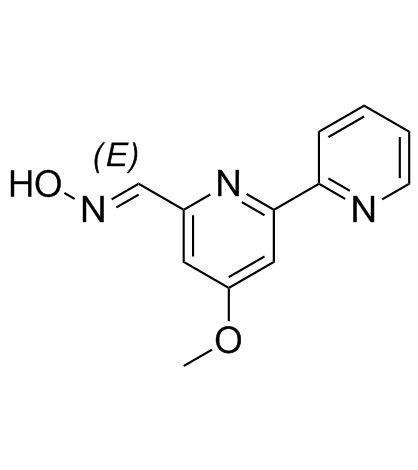
-
GC40490
Caffeic Acid methyl ester
KaffeesÄuremethylester, ein antimikrobielles Mittel, zeigt moderate antimikrobielle und herausragende antimykobakterielle AktivitÄten.
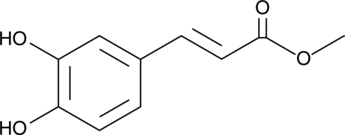
-
GC60668
Calcimycin hemimagnesium
Calcimycin (A-23187)-HÄmimagnesium ist ein Antibiotikum und ein einzigartiges Ionophor mit zweiwertigen Kationen (wie Calcium und Magnesium).
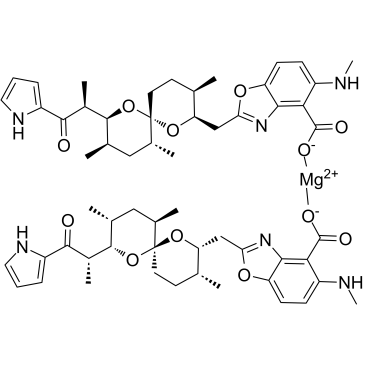
-
GC18922
Camalexin
Camalexin ist ein aus Camelina sativa (Cruciferae) isoliertes Phytoalexin mit antibakteriellen, antimykotischen, antiproliferativen und AntikrebsaktivitÄten.
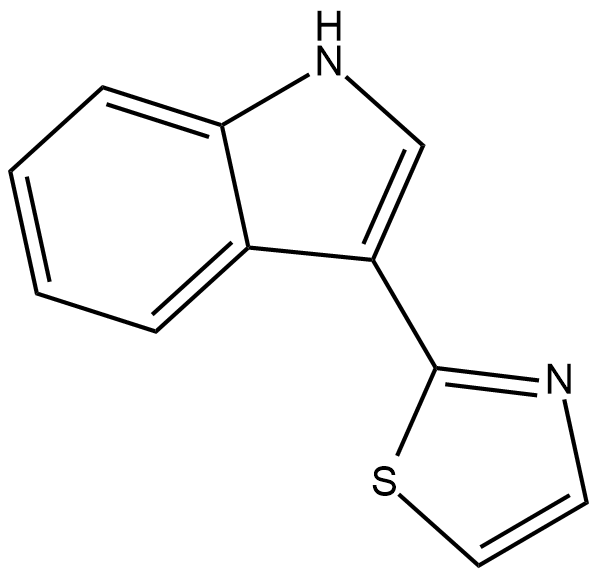
-
GC31953
Camphor ((±)-Camphor)
Campher ((±)-Campher) ((±)-Campher ((±)-Campher)) ist ein topisches Antiinfektivum und Antipruritikum und innerlich als Stimulans und Karminativum.
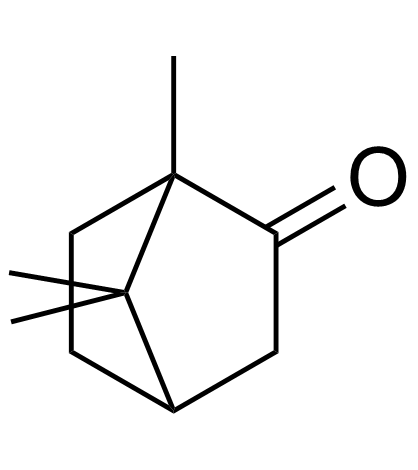
-
GC43138
CAP 3
CAP 3 is a cholic acid-peptide conjugate (CAP) with antibacterial activity.
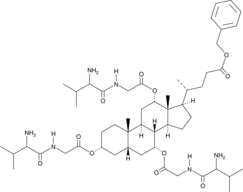
-
GC16198
Capreomycin Sulfate
Capreomycinsulfat ist ein Peptid-Antibiotikum, das Üblicherweise den Aminoglykosiden zugeordnet wird und in Kombination mit anderen Antibiotika gegen MDR-Tuberkulose verabreicht wird.
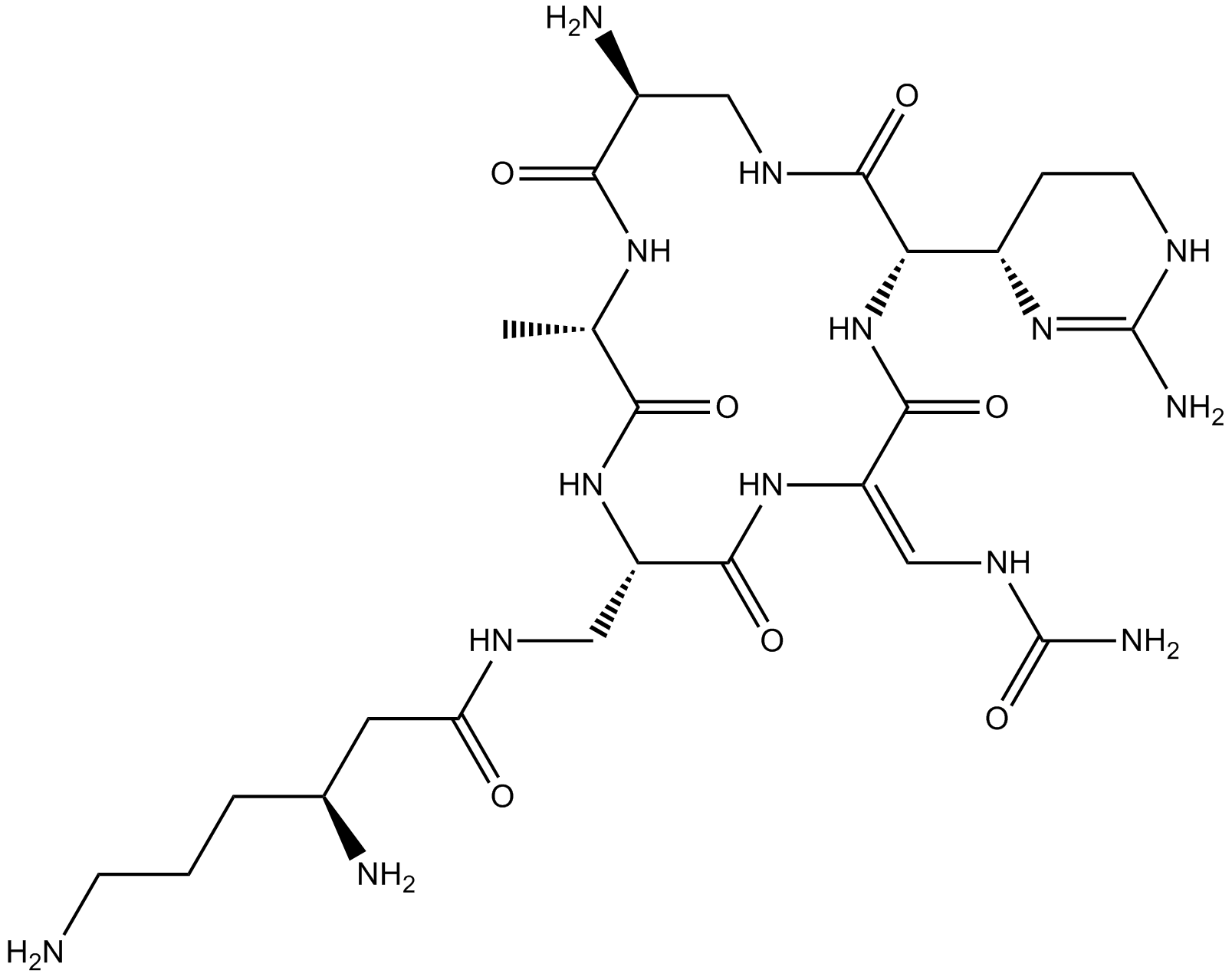
-
GC47035
Captan
Captan ist ein gÄngiges landwirtschaftliches Fungizid, das zur BekÄmpfung von Botrytis, Fusarium, Fusicoccum und Pythium verwendet wird.
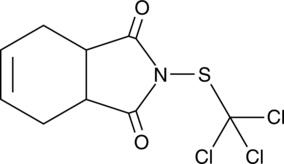
-
GC35604
Carabrone
Carabrone wird aus den FrÜchten von Carpesium abrotanoides isoliert, ist ein bekanntes Sesquiterpen und weist signifikante antibakterielle und AntitumoraktivitÄten auf.
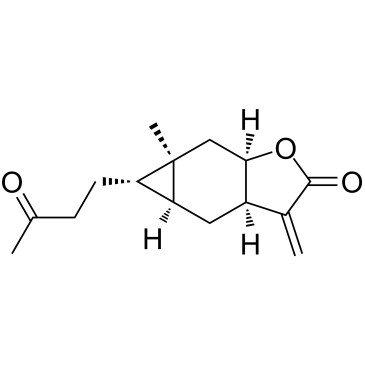
-
GC38896
Caracemide
Caracemid (NSC-253272) hemmt das Enzym Ribonukleotidreduktase von Escherichia coli.
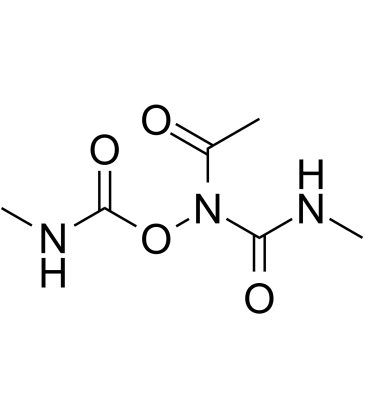
-
GC16295
Carbadox
Carbadox ist eine antibiotische Chinoxalin-Di-N-oxid-Verbindung, die in großem Umfang an Schweine im Aufzuchtalter verfÜttert wird, um Darmerkrankungen zu kontrollieren und die Futtereffizienz zu verbessern.
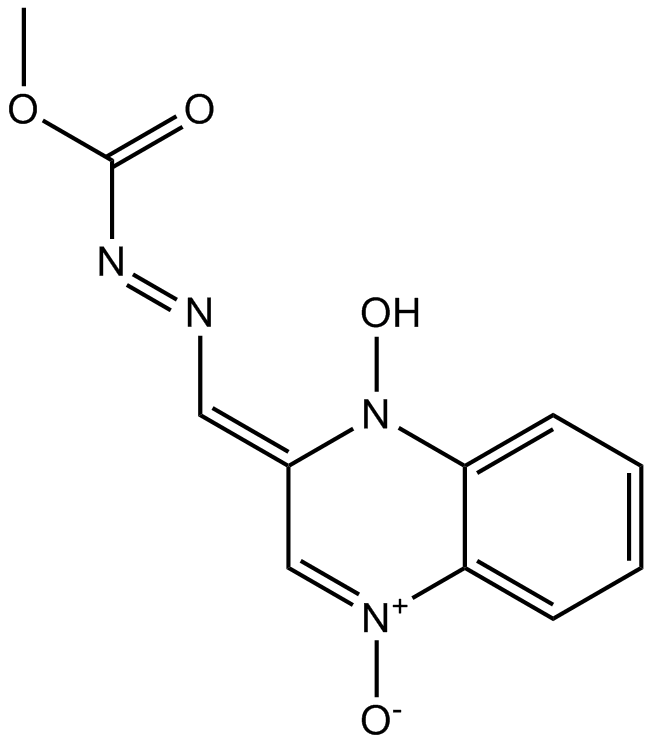
-
GC32147
Carbendazim
Carbendazim ist ein starkes und oral aktives Breitspektrum-Benzimidazol-Fungizid und kann als Pestizid fÜr die Erforschung von Pilzkrankheiten wie Seproria,FusariumundSclerotina eingesetzt werden.
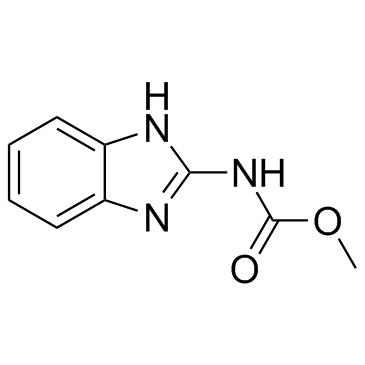
-
GC16053
Carbenicillin
Carbenicillin ist ein halbsynthetisches Penicillin-Derivat mit breitem Spektrum, das parenteral verwendet wird.
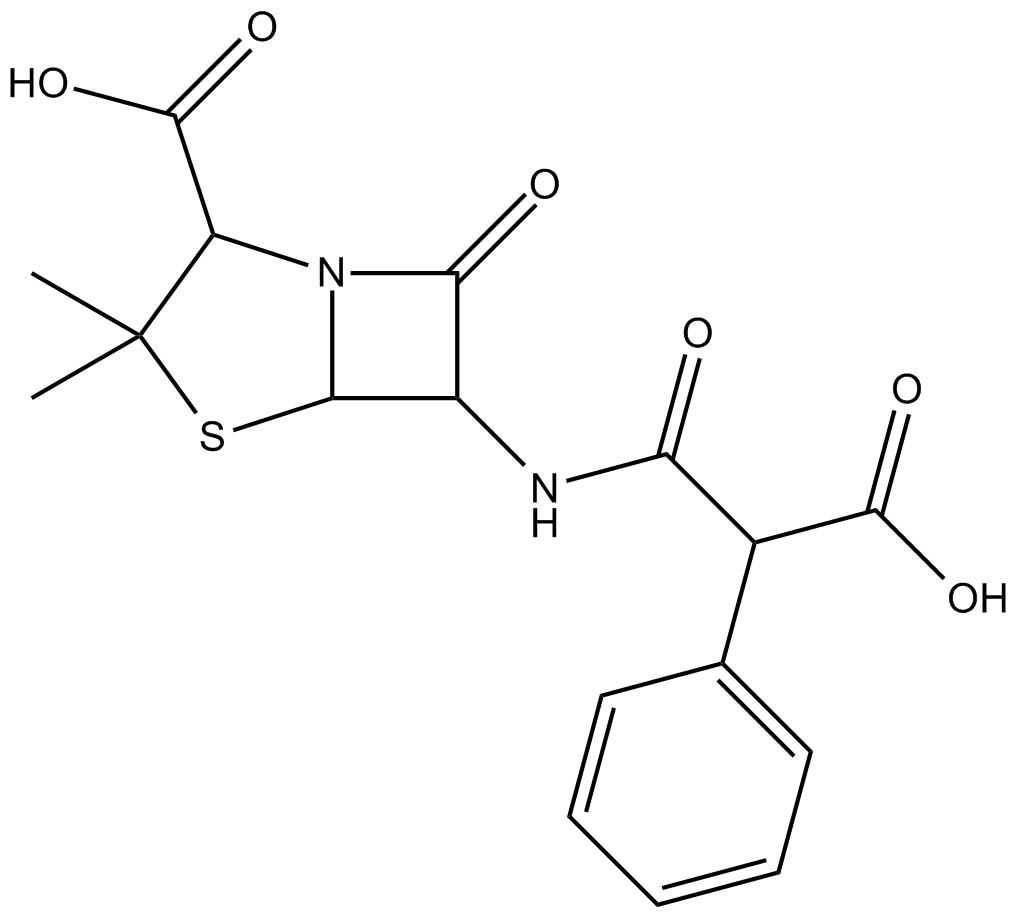
-
GC17633
Carbenicillin, Disodium Salt
A carboxypenicillin antibiotic
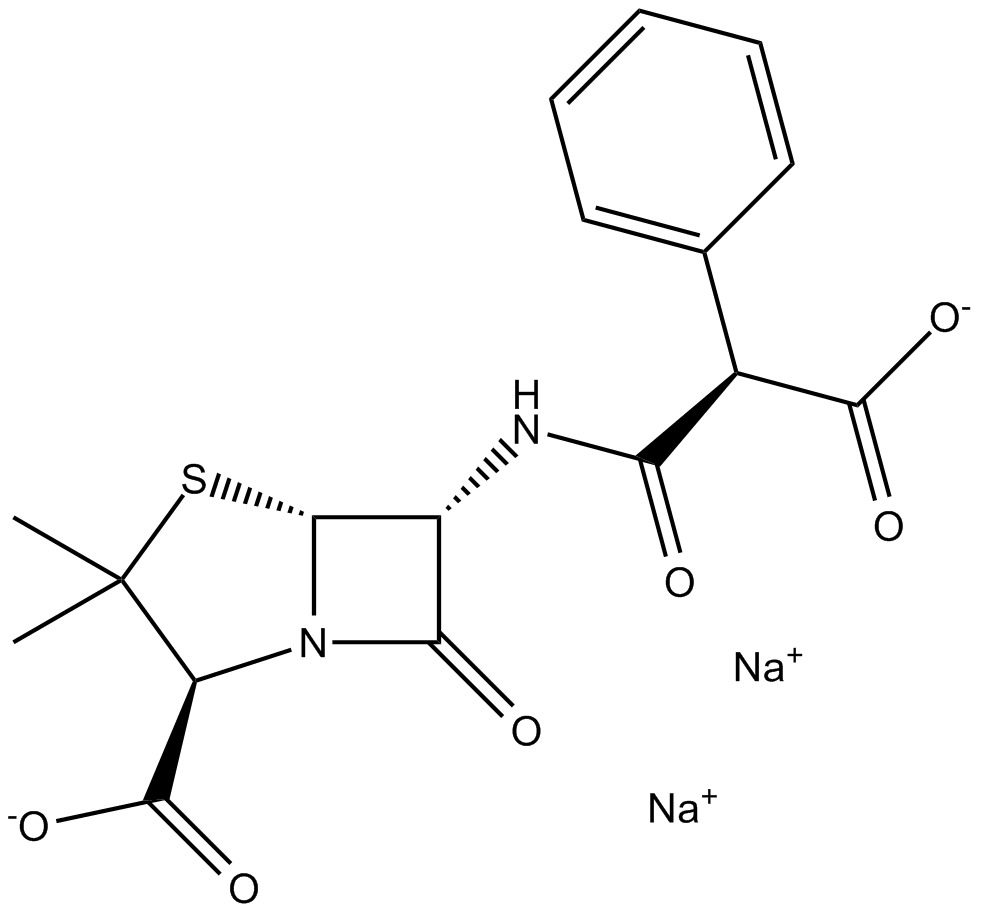
-
GC60099
Carbocisteine
Carbocistein, ein Mukolytikum, kann zur Erforschung der chronisch obstruktiven Lungenerkrankung (COPD) eingesetzt werden.
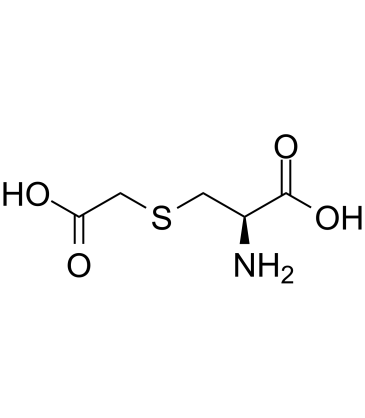
-
GC35606
Carbodine
Carbodin (Carbozyklisches Cytidin) ist ein antivirales Breitbandmittel, das gegen DNA-Viren, (+)RNA-Viren, (-)RNA-Viren, Paramyxo-, Rhabdo- und (+/-)RNA-Viren aktiv ist und auf CTP-Synthetase abzielt der UTP in CTP umwandelt.
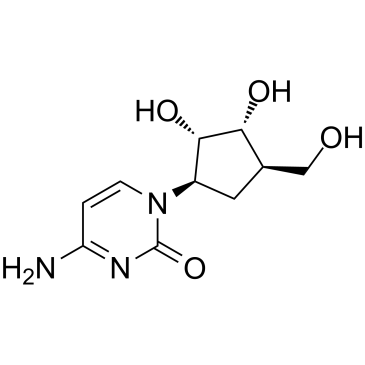
-
GC32257
Carbosulfan
Carbosulfan hemmte relativ stark CYP3A4 und mÄßig CYP1A1/2 und CYP2C19 in gepoolten HLM (menschliche Lebern).
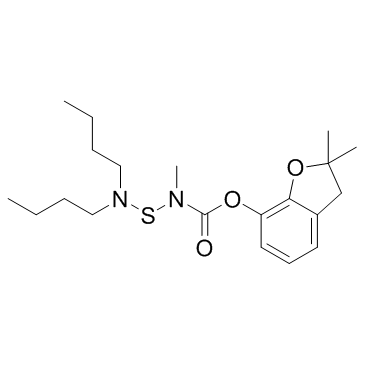
-
GC32331
Carboxin (Carboxine)
Carboxin (Carboxine) (Carboxin (Carboxine)e) ist ein systemisches landwirtschaftliches Fungizid und Saatgutschutzmittel.
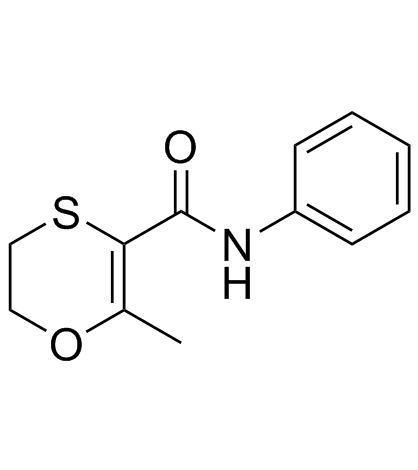
-
GC15089
Carfilzomib (PR-171)
A proteasome inhibitor
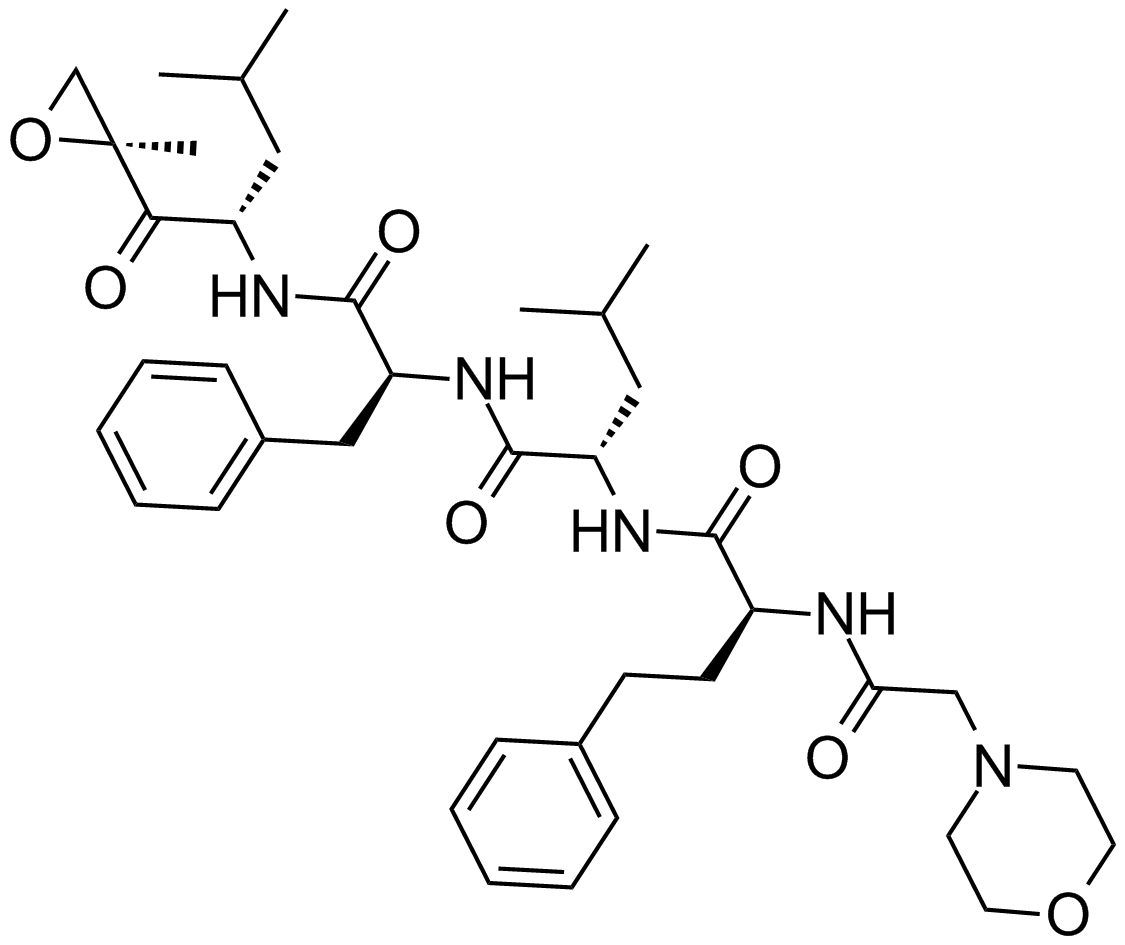
-
GC63565
Carindacillin sodium
Carindacillin (Carbenicillin-Indanyl)-Natrium ist ein oral aktiver antimikrobieller Wirkstoff mit breitem Wirkungsspektrum.
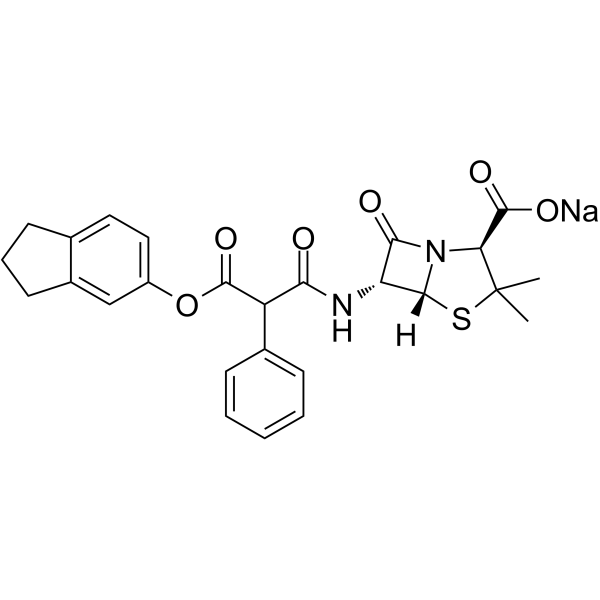
-
GC14964
Carminomycin
antitumor antibiotic
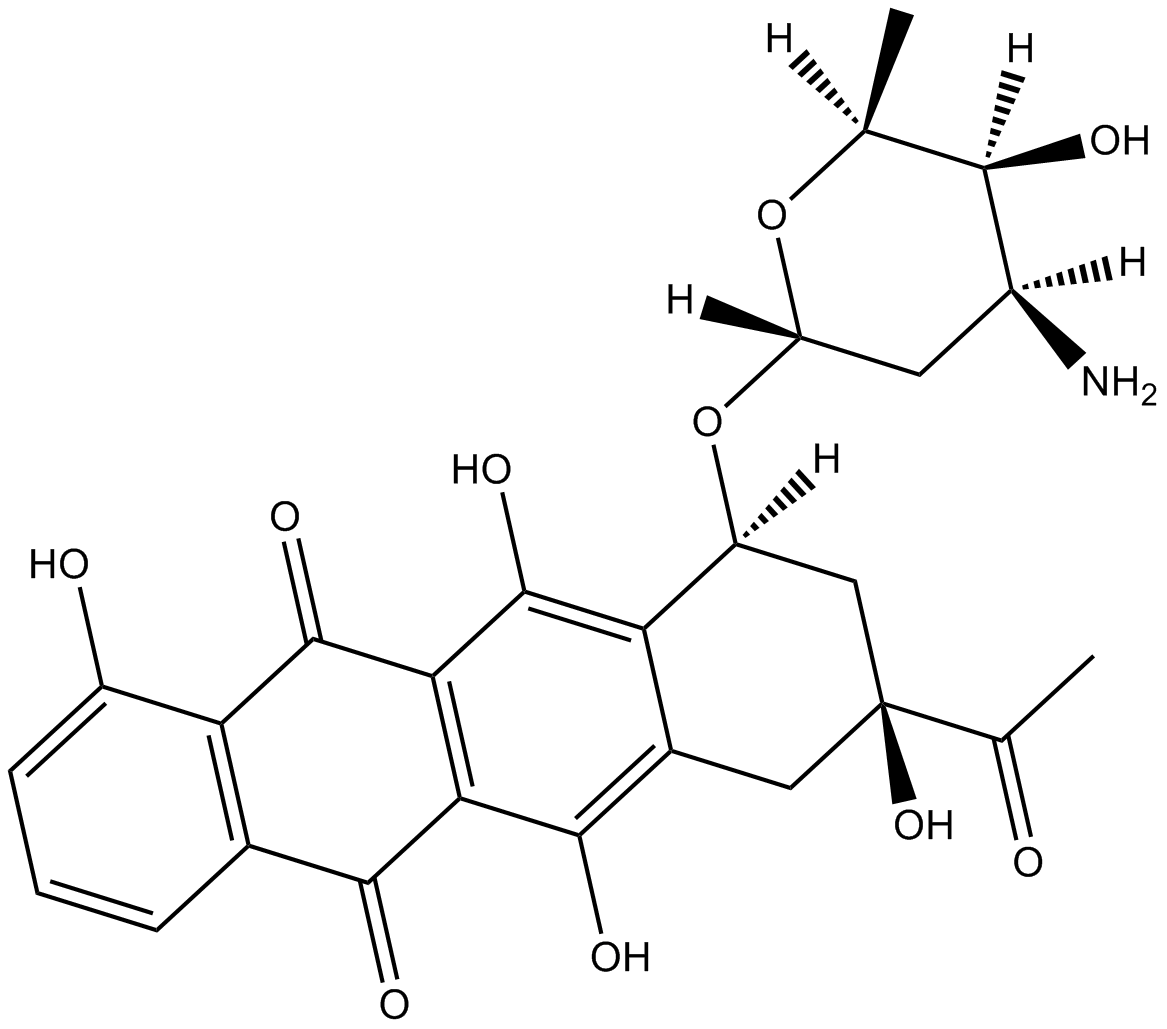
-
GN10733
Carnosic acid
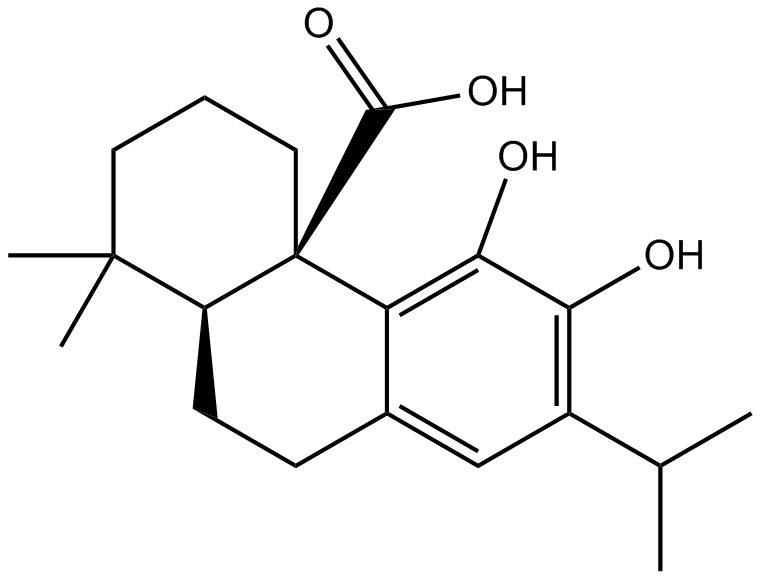
-
GC35611
Carpaine
Carpaine ist ein aus Carica papaya Linn isoliertes Alkaloid mit antithrombozytopenischer AktivitÄt, das eine starke AktivitÄt zur Aufrechterhaltung der BlutplÄttchenzahl ohne akute ToxizitÄt aufweist.
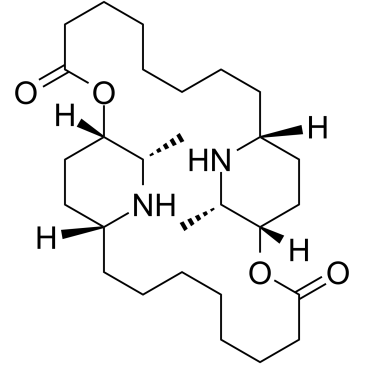
-
GC62887
Carpaine hydrochloride
Carpainhydrochlorid ist ein aus Carica papaya Linn isoliertes Alkaloid mit antithrombozytopenischer AktivitÄt, das eine starke AktivitÄt bei der Aufrechterhaltung der BlutplÄttchenzahl ohne akute ToxizitÄt aufweist.
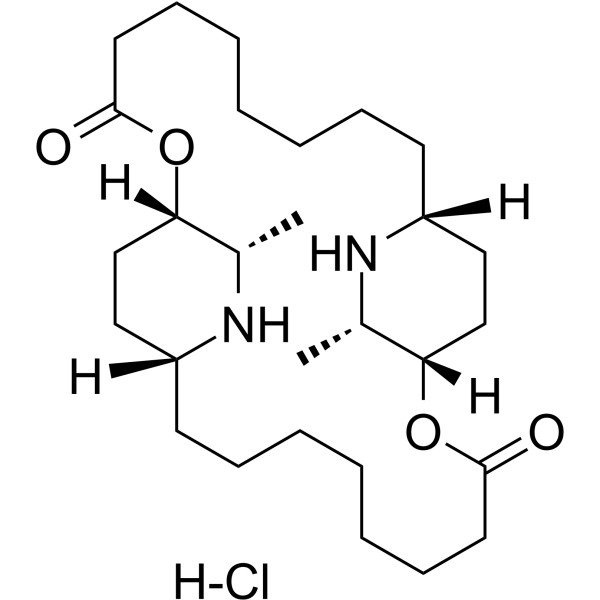
-
GC35612
Carvacrol
Carvacrol ist ein monoterpenoides Phenol, das aus Thymus mongolicus Ronn isoliert wird.
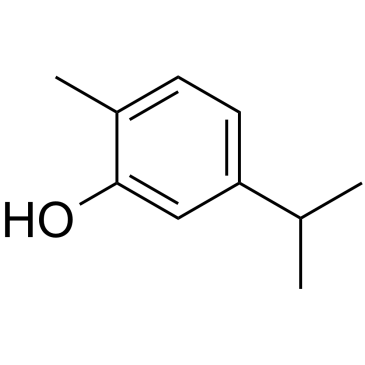
-
GC61640
Carvacrol methyl ether
Carvacrolmethylether, ein Carvacrol-Analogon, kann aus flÜchtigem PflanzenÖl isoliert werden.
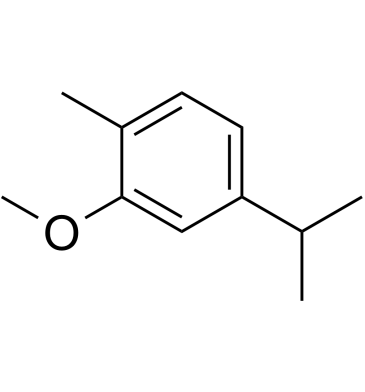
-
GC10303
Caspofungin Acetate
Caspofungin (MK-0991) Diacetat ist ein starkes Antimykotikum.
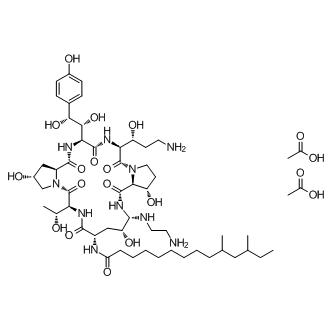
-
GC32841
Catechin ((+)-Catechin)
Catechin ((+)-Catechin) ((+)-Catechin ((+)-Catechin)) hemmt Cyclooxygenase-1 (COX-1) mit einem IC50 von 1,4 μM.
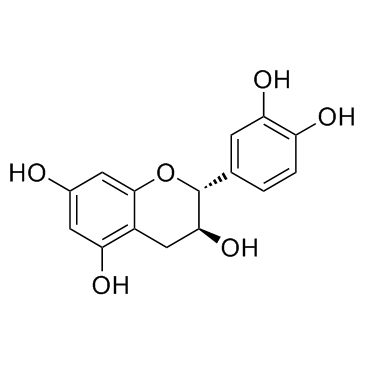
-
GC64117
Caulilexin C
Caulilexin C ist ein Phytoalexin aus KreuzblÜtlern mit antimykotischer AktivitÄt.
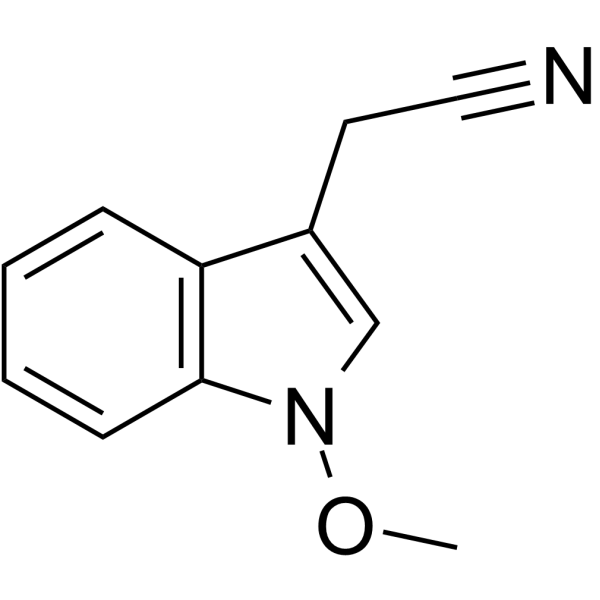
-
GC60100
Cauloside A
Kaulosid A (Leontosid A) ist ein Saponin, das aus Wurzeln von Dipsacus asper isoliert wird.
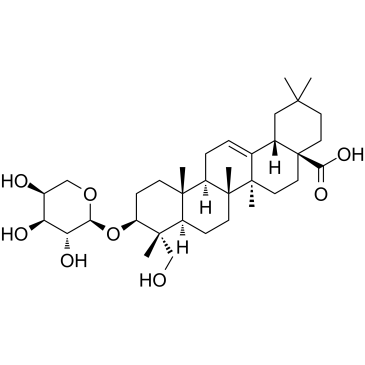
-
GC18910
CAY10654
The gram-negative pathogen Pseudomonas aeruginosa uses N-acylated-L-homoserine lactones (AHLs) in quorum sensing to modulate transcriptional activators, including LasR, and regulate the expression of virulence factors.
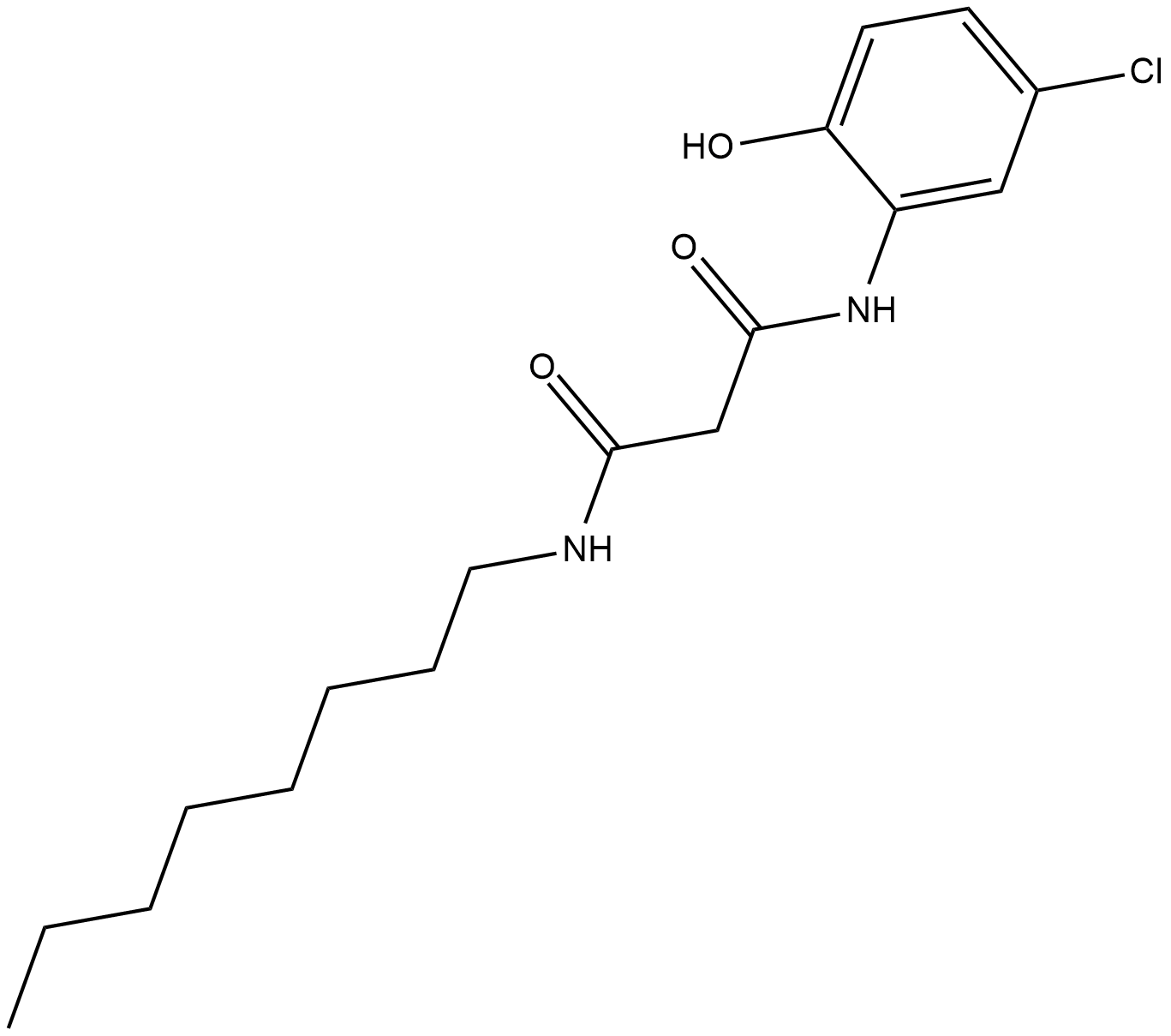
-
GC43196
CAY10704
CAY10704 is a potent inhibitor of hepatitis C virus (HCV) infection (EC50 = 17 nM) that displays low cytotoxicity of virally-infected human hepatoma Huh7.5.1 cells (CC50 = 21.3 μM).
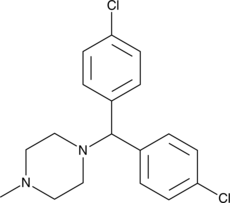
-
GC43197
CAY10711
CAY10711 is a substituted diamine that produces rapid bactericidal activity against both Gram-positive and Gram-negative bacteria, including methicillin-resistant S.
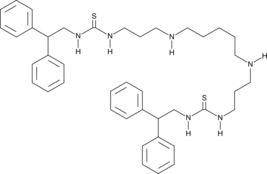
-
GC47052
CAY10742
An oxadiazole antibiotic
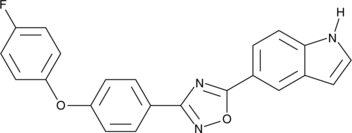
-
GC47062
CAY10766
An antiviral compound
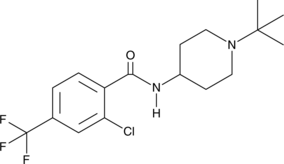
-
GC49139
CAY10784
A STAT3 inhibitor
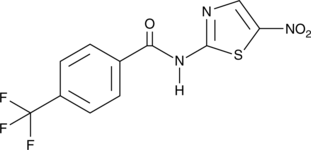
-
GC62116
CBS1117
CBS1117 ist ein Viruseintrittshemmer mit einem IC50 von 70 nM fÜr das Influenza-A-Virus, A/Puerto Rico/8/34 (H1N1).
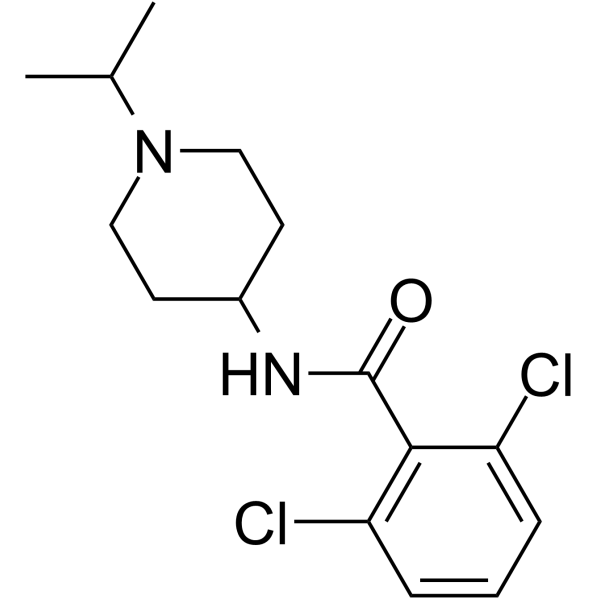
-
GC14727
CCCP
Carbonylcyanid-3-chlorphenylhydrazon (CCCP) ist ein Protonophor, der das Entkoppeln des Protonengradienten in der inneren Mitochondrienmembran bewirkt und somit die ATP-Syntheserate hemmt.
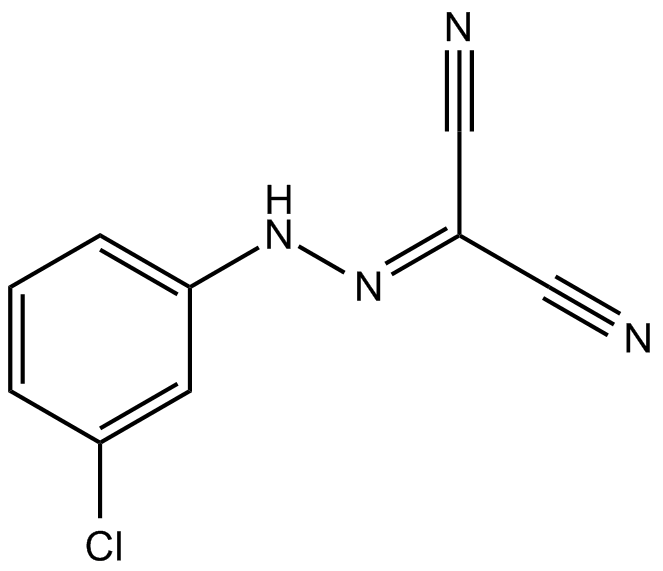
-
GC63779
CCF0058981
CCF0058981 (CCF981), 3-Chlorphenyl-Analogon, ist ein nicht-kovalenter SARS-CoV-2 3CLpro (SC2)-Inhibitor mit einem IC50 von 68 nM.
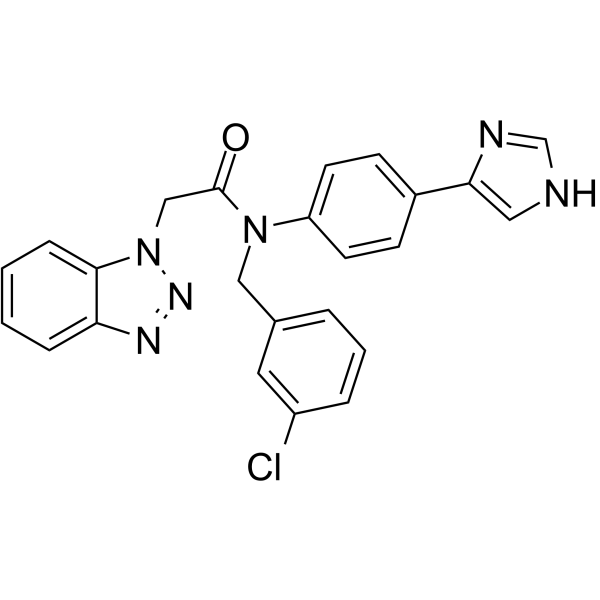
-
GC32367
CCR5 antagonist 1
CCR5-Antagonist 1 ist ein CCR5-Antagonist, der die HIV-Replikation hemmen kann, extrahiert aus WO 2004054974 A2.
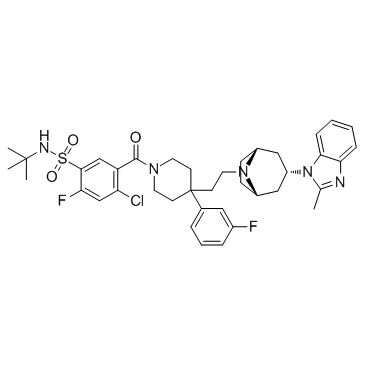
-
GC12871
CDK9 inhibitor
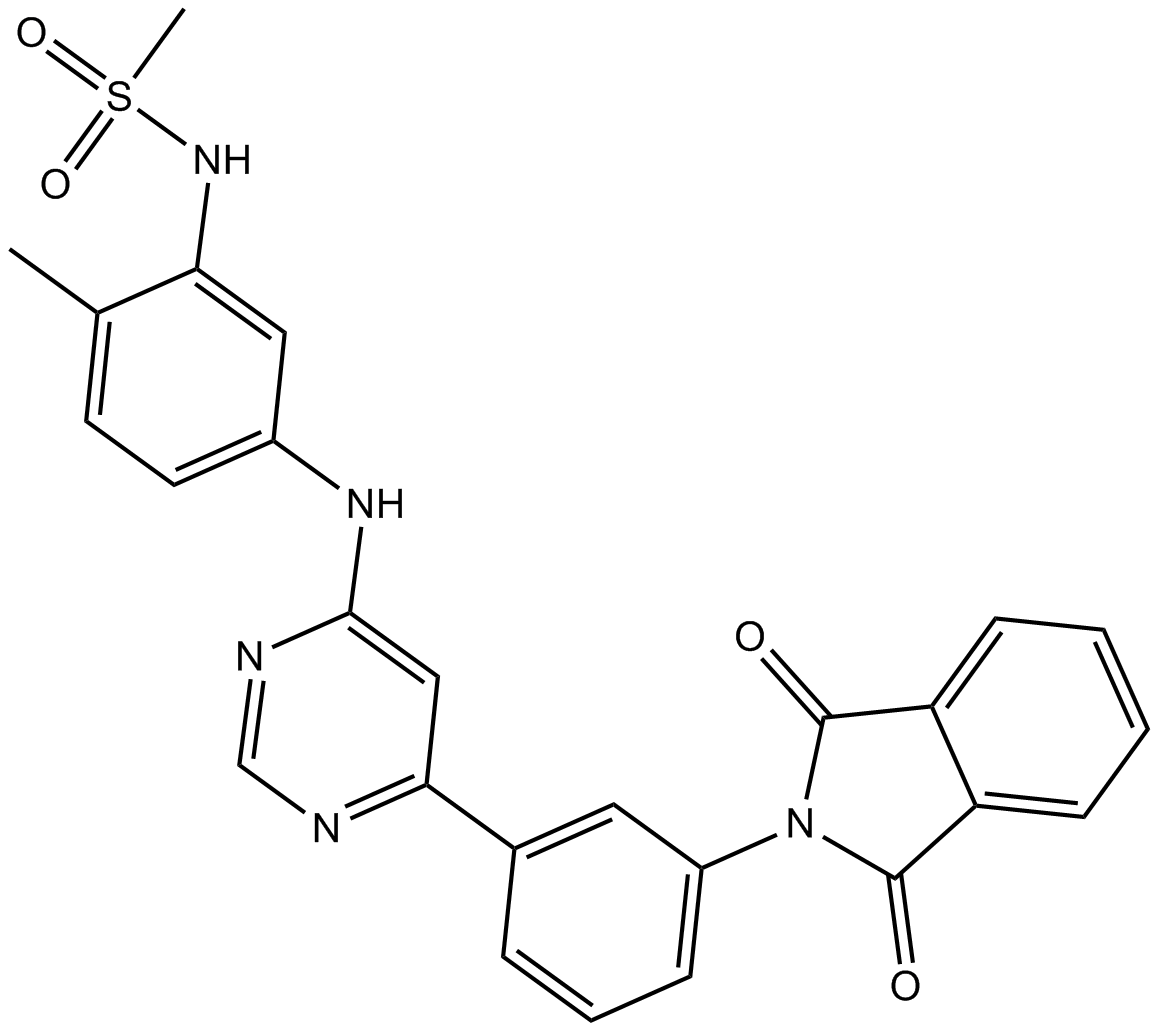
-
GC31773
Cecropin A
Cecropin A ist ein lineares, aus 37 Resten bestehendes antimikrobielles Polypeptid mit krebshemmender und entzÜndungshemmender Wirkung.
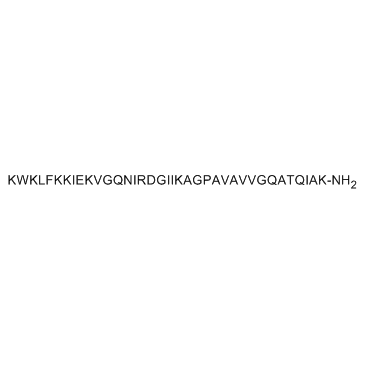
-
GC34229
Cecropin A TFA
Cecropin A TFA ist ein lineares antimikrobielles Polypeptid mit 37 Resten, das aus Hyalaphora cecropia-Puppen isoliert wurde.
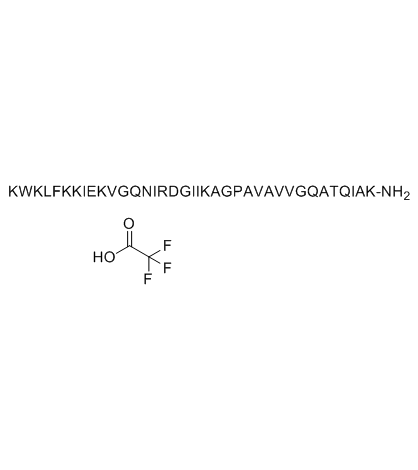
-
GC38681
Cedrol
Cedrol ist ein bioaktives Sesquiterpen, ein starker kompetitiver Inhibitor von Cytochrom P-450 (CYP)-Enzymen.
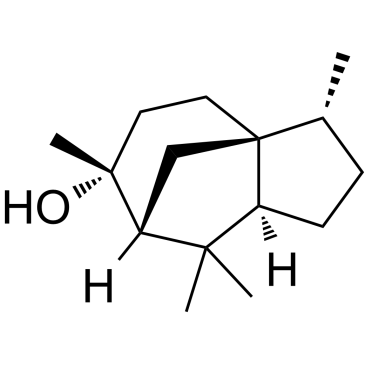
-
GC35639
CEF1, Influenza Matrix Protein M1 58-66
CEF1, Influenza Matrix Protein M1 58-66 ist ein Epitop, das vom Matrixprotein des Influenza-A-Virus abgeleitet ist.
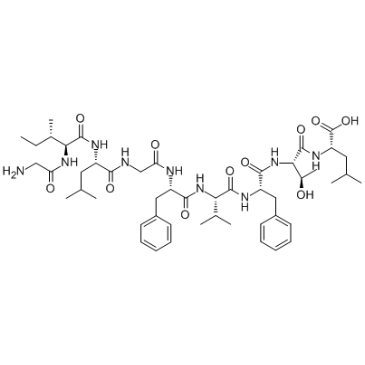
-
GC35642
CEF20
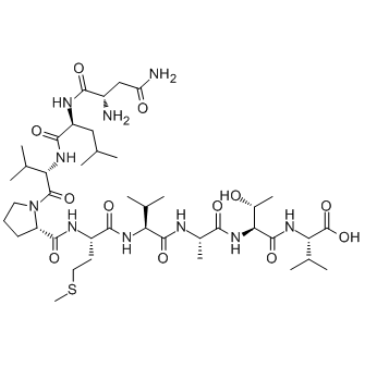
-
GC32293
CEF3
CEF3 (SIIPSGPLK) entspricht den AS 13-21 des Influenza-A-Virus-M1-Proteins.
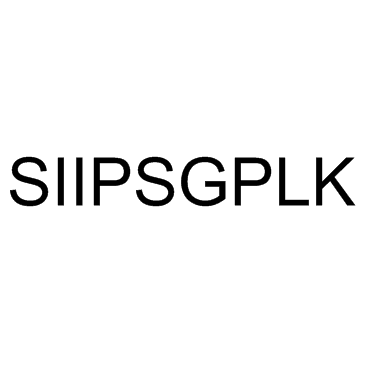
-
GC32329
CEF6
CEF6 ist ein 9 AminosÄuren langes Peptid, das den AminosÄuren 418-426 des Nukleokapsidproteins des Influenza-A-Virus (H1N1) entspricht.
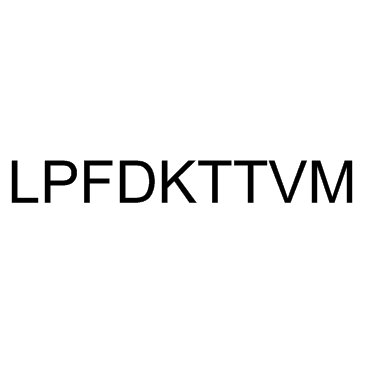
-
GC65613
Cefaclor
Cefaclor ist ein gut resorbierbares, oral wirksames Cephalosporin-Antibiotikum. Cefaclor kann spezifisch an das fÜr Penicillin bindende Protein 3 (PBP3) binden. Cefaclor kann zur Erforschung von Infektionen eingesetzt werden, die durch Bakterien verursacht werden, wie z. B. Atemwegsinfektionen, bakterielle Bronchitis, Pharyngitis und Hautinfektionen.
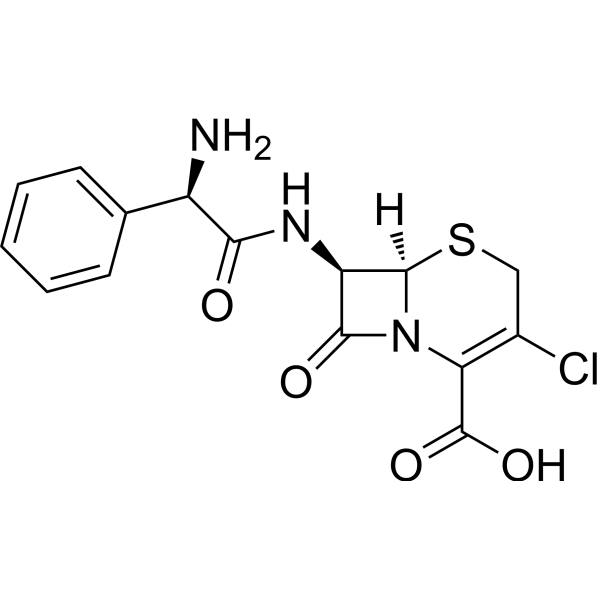
-
GC32099
Cefadroxil (BL-S 578)
Cefadroxil (BL-S 578) ist ein Breitbandantibiotikum vom Cephalosporin-Typ, das bei grampositiven und gramnegativen bakteriellen Infektionen wirksam ist.
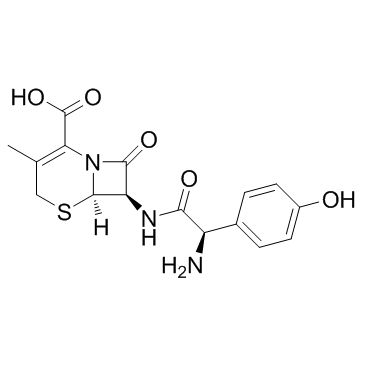
-
GC16253
Cefadroxil (hydrate)
Cefadroxil (Hydrat) (BL-S 578 Hydrat) ist ein oral wirksames Cephalosporin der ersten Generation mit einem breiten antibakteriellen Wirkungsspektrum.
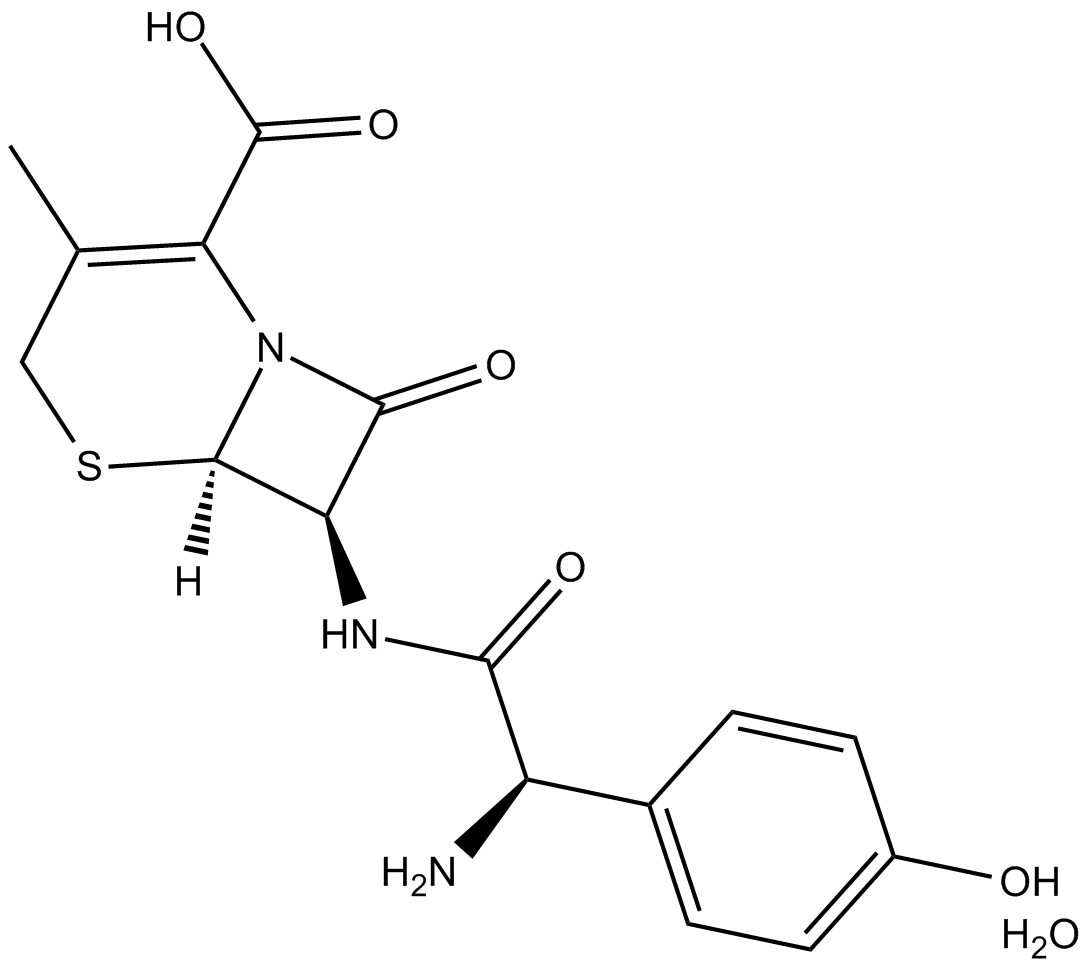
-
GC48489
Cefadroxil-d4 (trifluoroacetate salt)
An internal standard for the quantification of cefadroxil
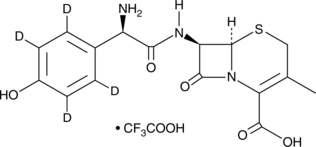
-
GC49274
Cefalonium
A cephalosporin antibiotic
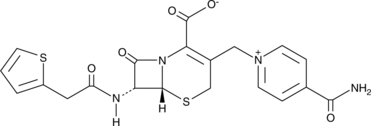
-
GC32240
Cefamandole (Cephamandole)
Cefamandole (Cephamandole) ist ein Breitband-Cephalosporin-Antibiotikum der zweiten Generation.
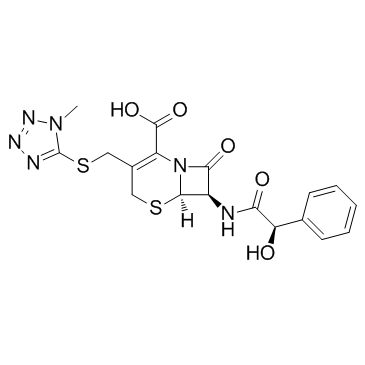
-
GC16920
Cefamandole (sodium salt)
Cefamandol-Natriumsalz ist ein Breitspektrum-Cephalosporin-Antibiotikum der zweiten Generation.
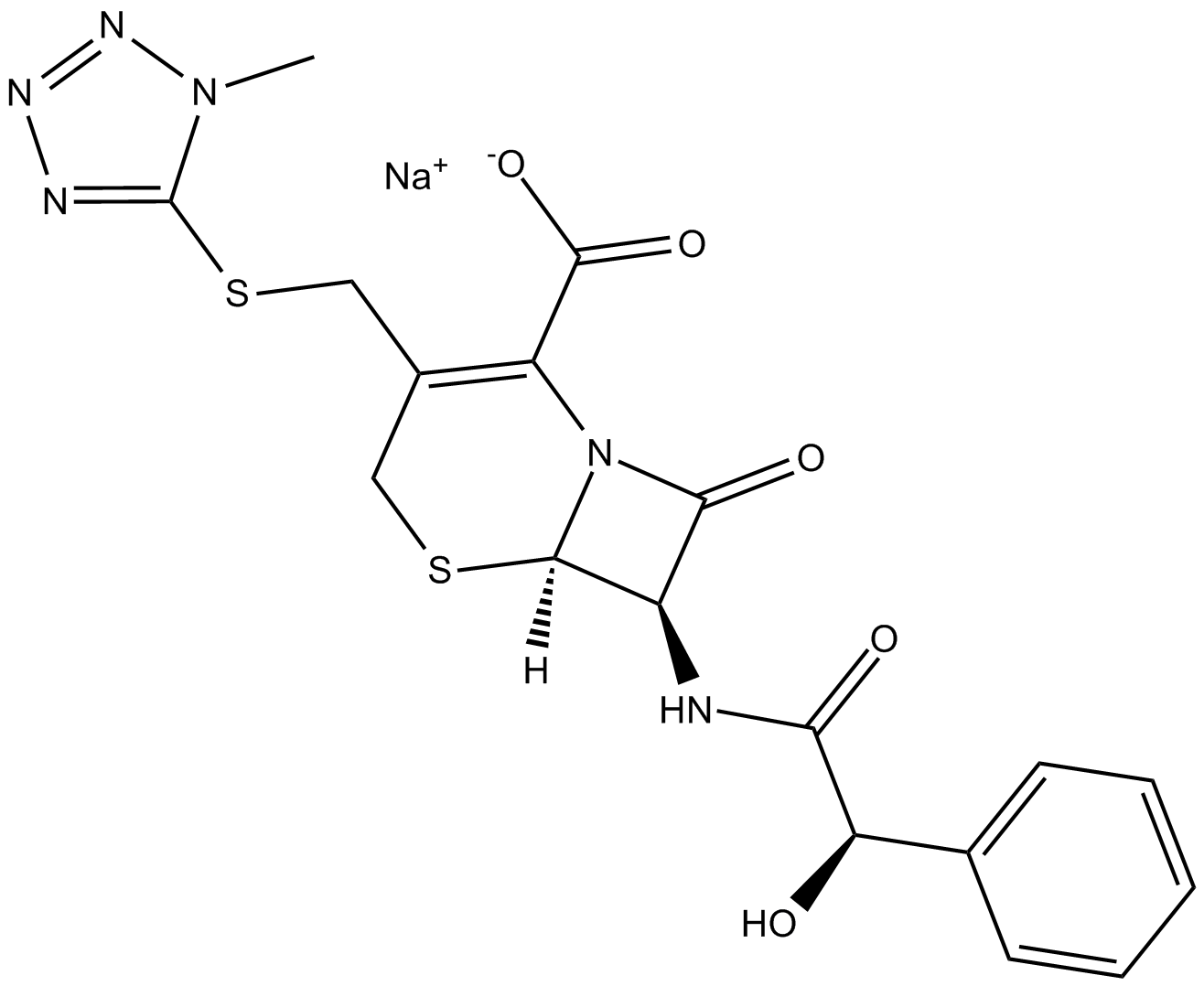
-
GC32123
Cefamandole nafate (Cefamandole formate sodium)
Cefamandol-Nafat (Cefamandol-Formiat-Natrium) (Cefamandol-Formiat-Natrium) ist ein Breitspektrum-Cephalosporin-Antibiotikum der zweiten Generation.
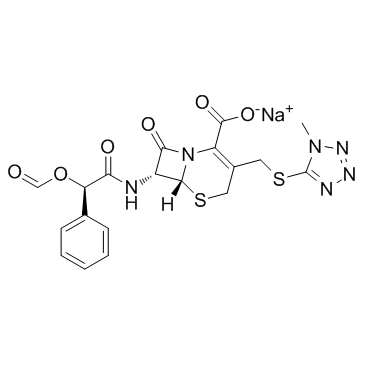
-
GC14253
Cefapirin
Cefapirin (Cefapirin) ist ein Ephalosporin-Antibiotikum mit antimikrobieller AktivitÄt mit breitem Spektrum.
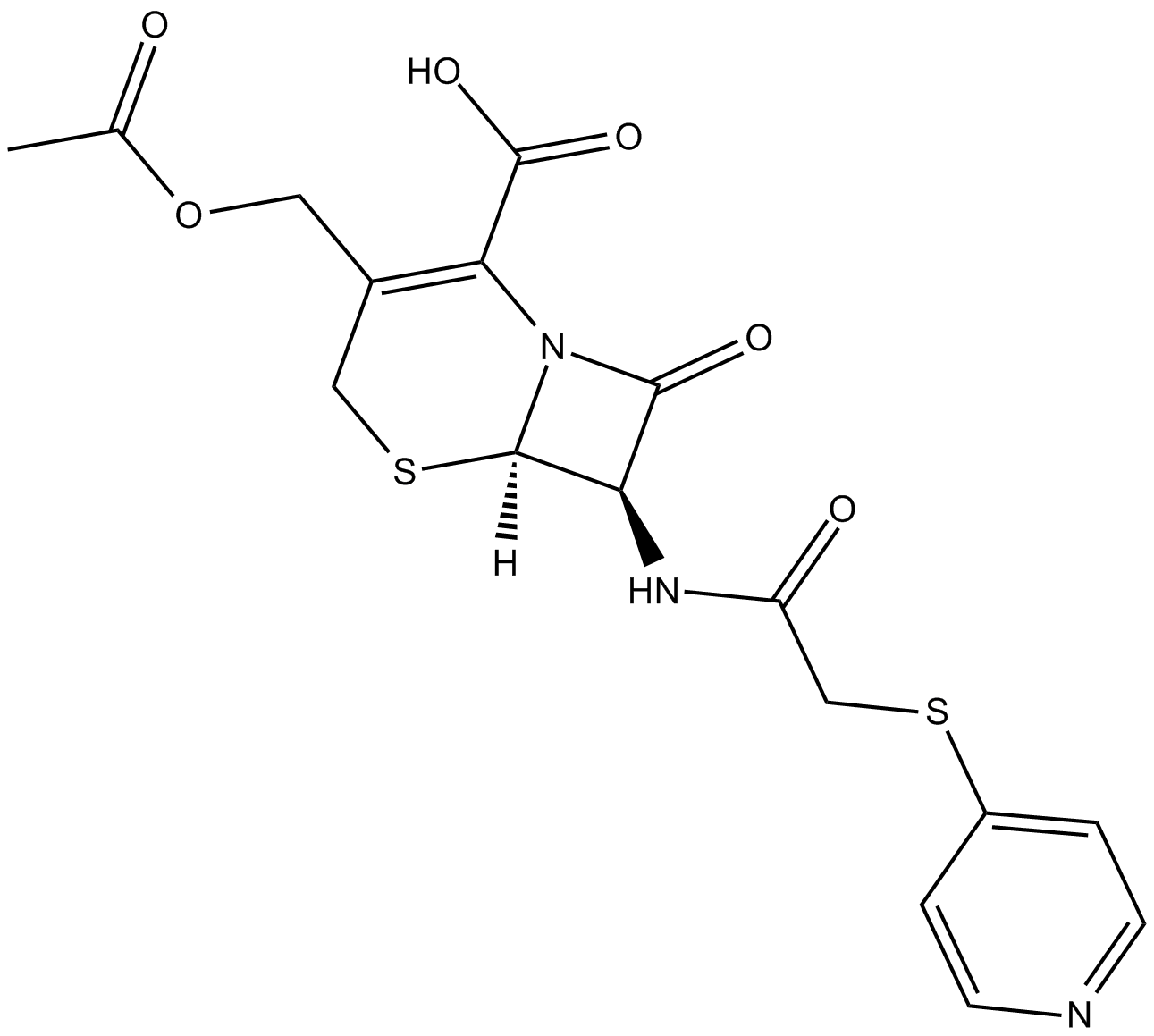
-
GC38750
Cefathiamidine
Cefathiamidin ist ein Cephalosporin-Antibiotikum der ersten Generation und wird zur Behandlung von Infektionen angewendet, die durch empfindliche Bakterien verursacht werden.
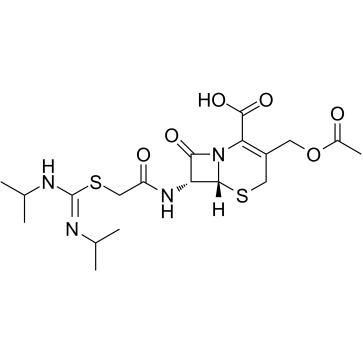
-
GC25208
Cefatrizine
Cefatrizine, a broad-spectrum, semisynthetic, first-generation cephalosporin with antibacterial activity, binds to and inactivates penicillin-binding proteins (PBPs) located on the inner membrane of the bacterial cell wall.
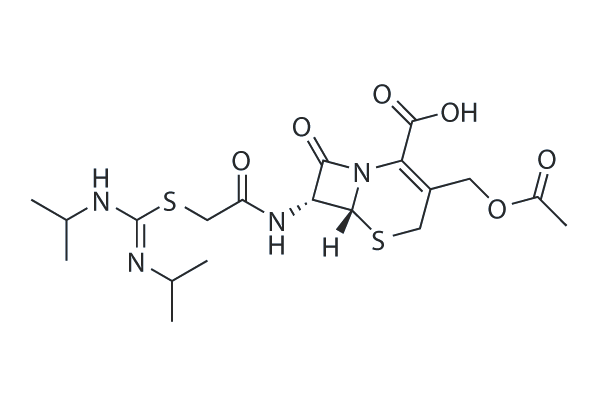
-
GC39542
Cefazedone
Cefazedon (Refosporen), ein Cephalosporin der ersten Generation, ist ein zeitabhÄngiges Antibiotikum mit AktivitÄt gegen grampositive und gramnegative Bakterien.
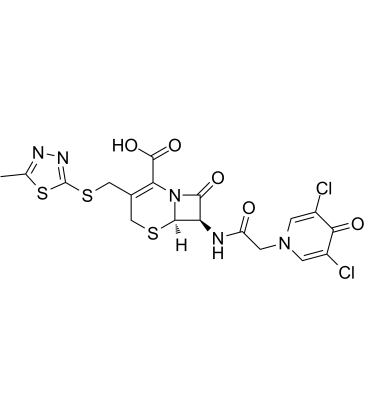
-
GC60683
Cefazolin
Cefazolin (Cephazolin) ist ein Cephalosporin-Antibiotikum der ersten Generation und kann in der Erforschung verschiedener bakterieller Infektionen eingesetzt werden.
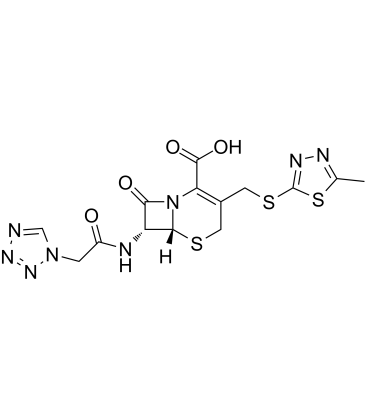
-
GC10179
Cefazolin (sodium salt)
Cefazolin (Natriumsalz) ist ein Cephalosporin-Antibiotikum der ersten Generation und kann in der Erforschung verschiedener bakterieller Infektionen eingesetzt werden.
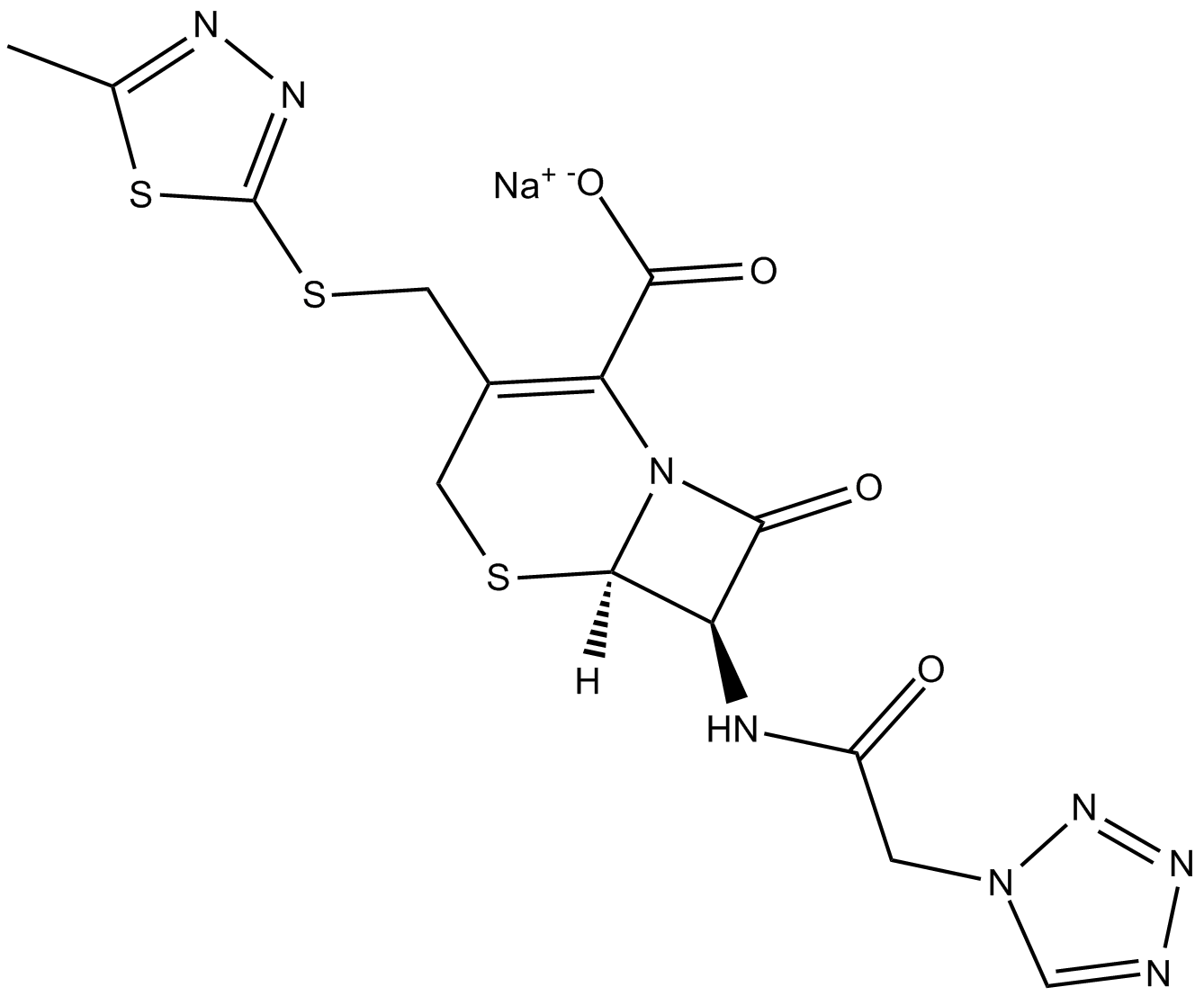
-
GC43222
Cefazolin-13C2,15N
Cefazolin-13C2,15N is intended for use as an internal standard for the quantification of cefazolin by GC- or LC-MS.
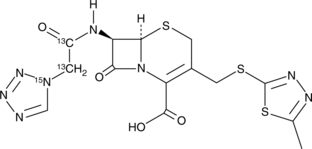
-
GC38751
Cefcapene pivoxil hydrochloride
Cefcapen-Pivoxil-Hydrochlorid, ein Antibiotikum, ist ein oral wirksames und wirksames Cephalosporin der 3. Generation mit einem breiten Spektrum an antibakterieller AktivitÄt.
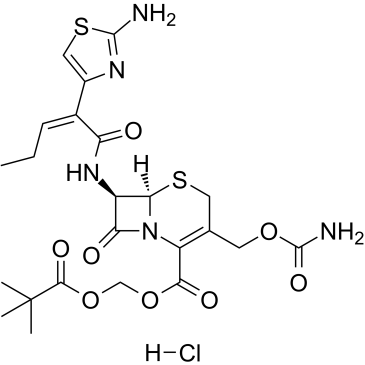
-
GC39602
Cefcapene pivoxil hydrochloride hydrate
Cefcapen-Pivoxil-Hydrochlorid-Hydrat ist ein Prodrug und ein oral aktives Cephalosporin der 3. Generation mit breitem antibakteriellem Wirkungsspektrum.
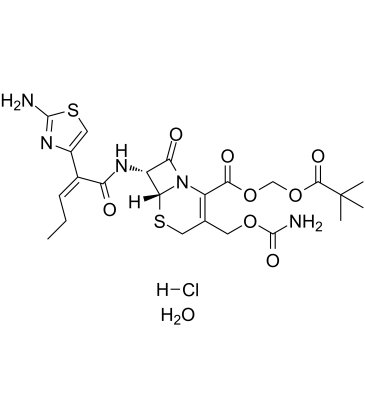
-
GC16083
Cefdinir
Cefdinir (FK-482) ist ein halbsynthetisches Breitbandantibiotikum der dritten Generation der Cephalosporin-Klasse, das sich als wirksam bei Infektionen erwiesen hat, die durch mehrere gramnegative und grampositive Bakterien verursacht werden.
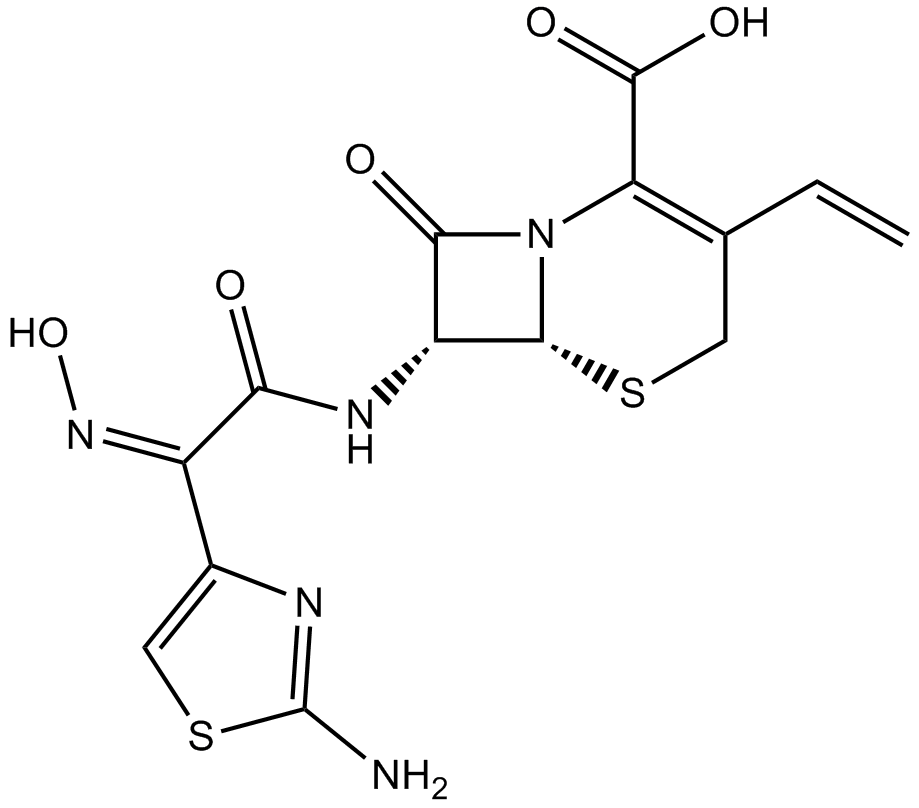
-
GC18036
Cefditoren Pivoxil
Cefditoren Pivoxil (ME 1207) ist ein orales Cephalosporin-Antibiotikum der dritten Generation mit breitem Wirkungsspektrum und verbesserter Stabilität gegen viele gängige β-Laktamasen.
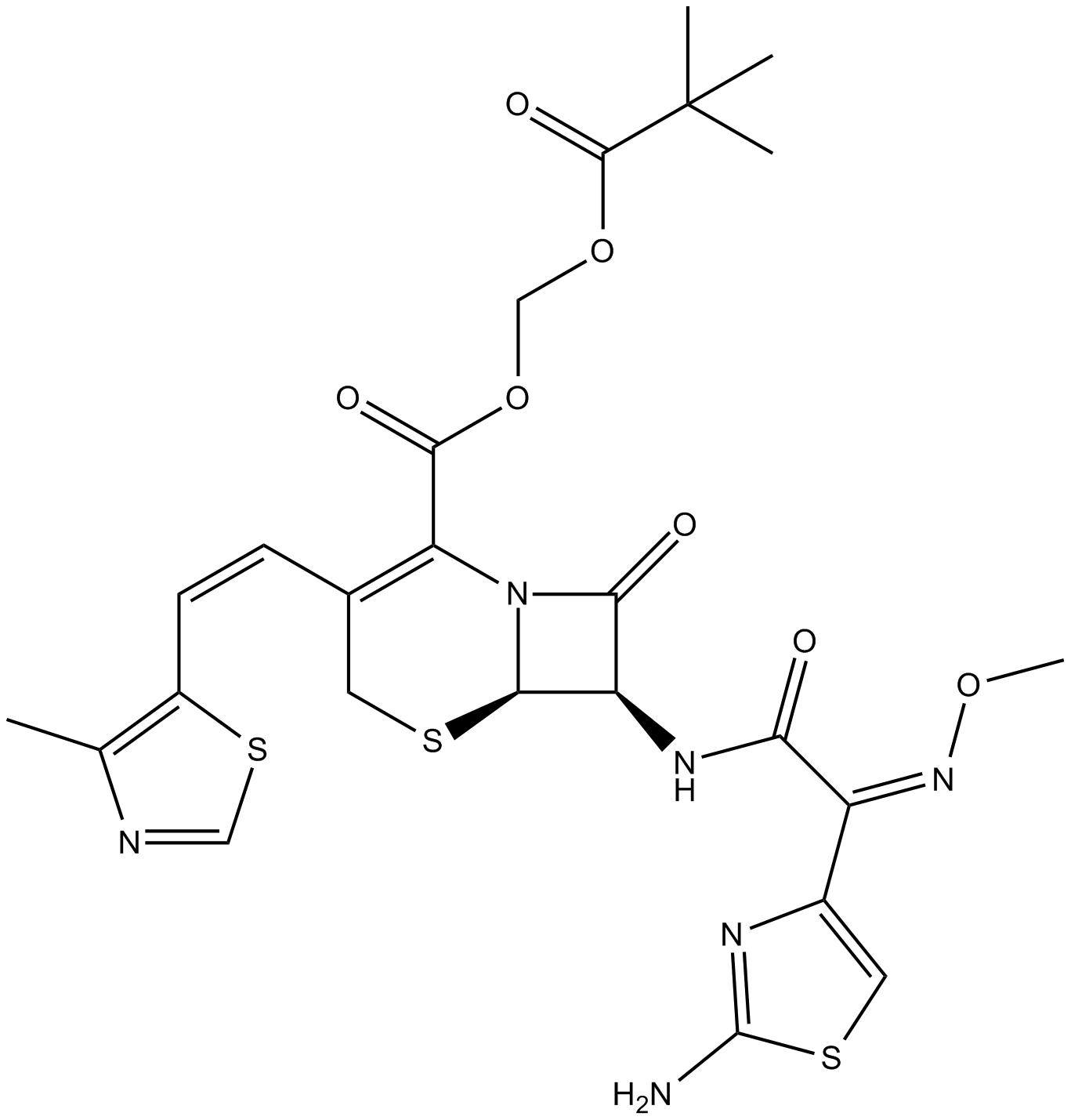
-
GC64043
Cefditoren sodium
Cefditoren-Natrium (ME 1206) ist ein orales Cephalosporin-Antibiotikum der dritten Generation mit breitem Wirkungsspektrum und verbesserter StabilitÄt gegen viele gÄngige β-Laktamasen.
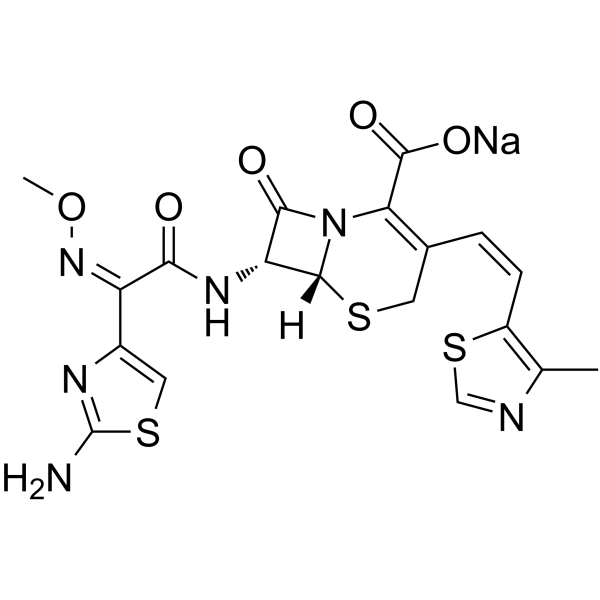
-
GC13111
Cefepime Dihydrochloride Monohydrate
Cefepim-Dihydrochlorid-Monohydrat ist ein Breitspektrum-Cephalosporin mit verbesserter Wirkung gegen grampositive und gramnegative Bakterien.

-
GC63974
Cefetamet
Cefetamet ist ein Cephalosporin-Antibiotikum.
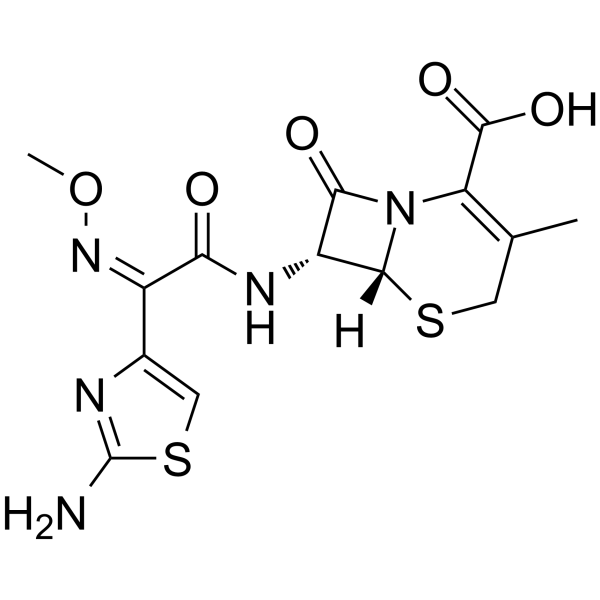
-
GC33952
Cefetamet pivoxil hydrochloride (Ro 15-8075)
Cefetamet Pivoxilhydrochlorid (Ro 15-8075) ist ein orales Cephalosporin-Antibiotikum der dritten Generation.
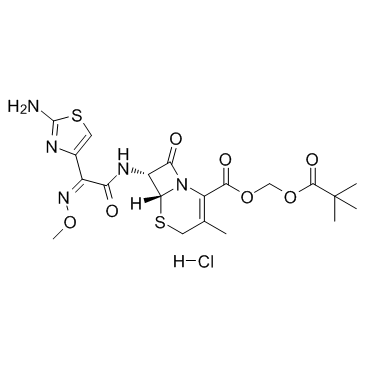
-
GC32079
Cefiderocol (S-649266)
Cefiderocol (S-649266) ist ein Siderophor-Cephalosporin, das eine starke Aktivität gegen eine breite Palette von aeroben gramnegativen Bakterienarten mit MIC50-Werten von 2 μg/mL oder weniger aufweist.
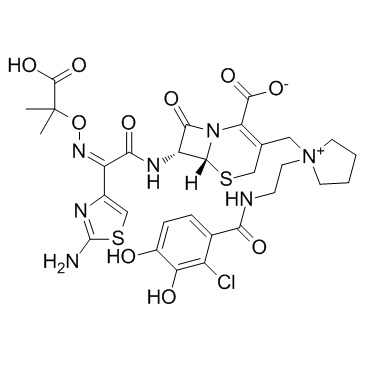
-
GC14341
Cefixime
Cefixim ist ein Antibiotikum und ein Cephalosporin-Antibiotikum der dritten Generation, das fÜr die Behandlung einer Reihe von bakteriellen Infektionen nÜtzlich ist.
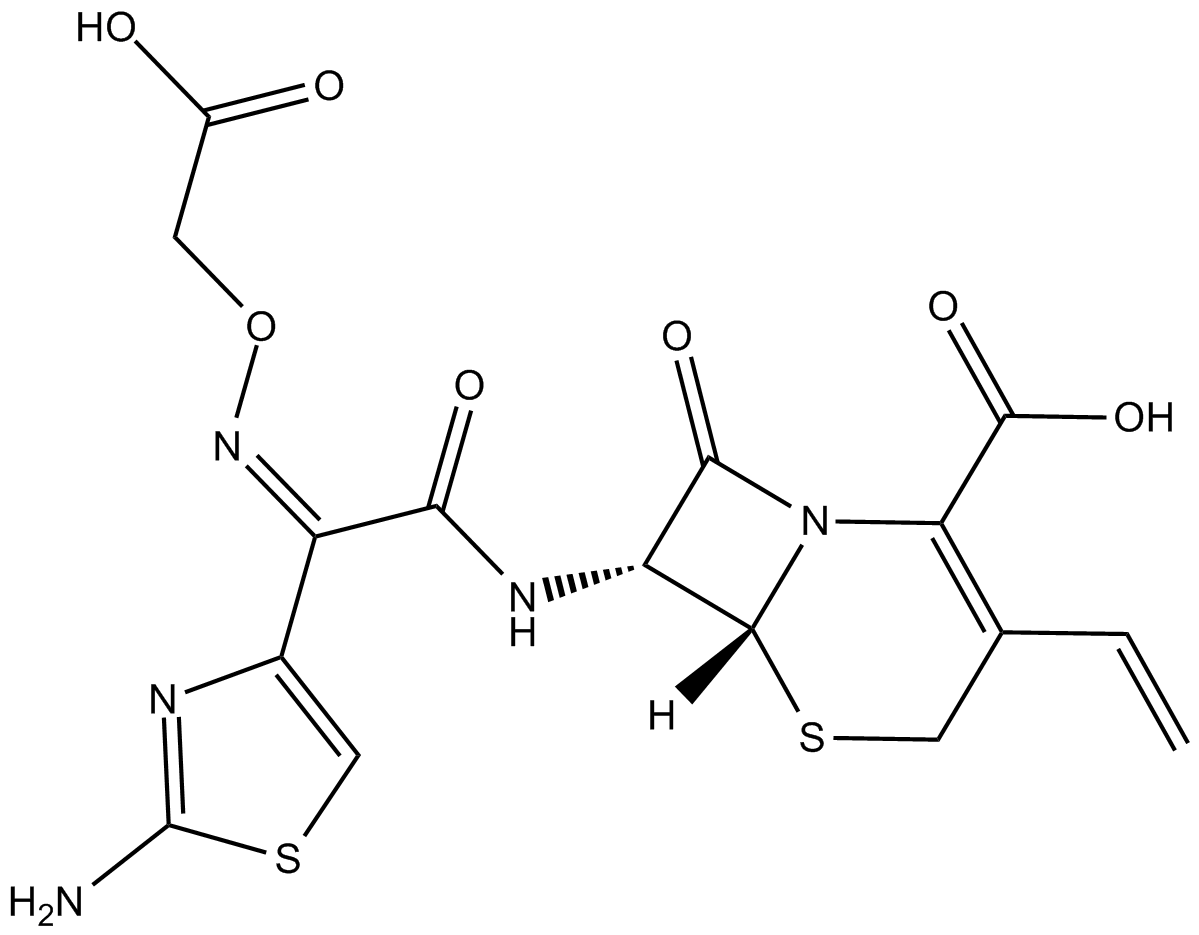
-
GC32235
Cefmenoxime hydrochloride (Cefmenoxime hemihydrochloride)
Cefmenoxim (SCE-1365) Hydrochlorid ist ein neues halbsynthetisches Cephalosporin-Antibiotikum.
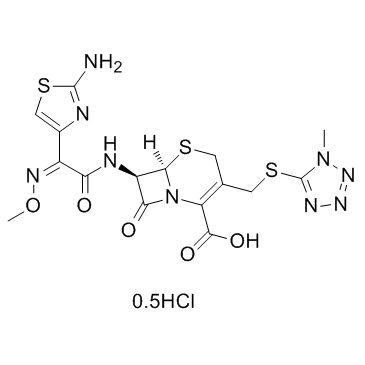
-
GC47068
Cefmetazole
Cefmetazol (CS 1170) ist ein halbsynthetisches Cephamycin-Antibiotikum mit antibakterieller Breitbandwirkung, das grampositive, gramnegative und anaerobe Bakterien abdeckt.
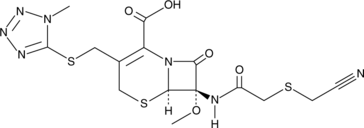
-
GC32168
Cefmetazole sodium (Sodium cefmetazole)
Cefmetazol-Natrium (Natrium-Cefmetazol) (Natrium-Cefmetazol) ist ein halbsynthetisches Cephamycin-Antibiotikum mit antibakterieller BreitbandaktivitÄt, das grampositive, gramnegative und anaerobe Bakterien abdeckt.
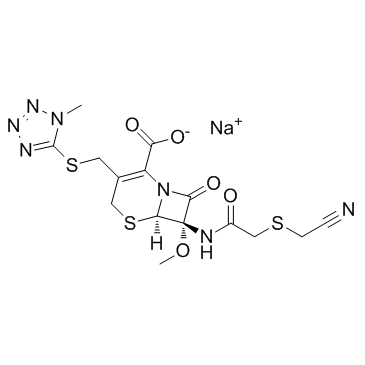
-
GC61805
Cefminox sodium
Cefminox-Natrium (MT-141) ist ein halbsynthetisches Cephamycin, das ein breites Spektrum an antibakterieller AktivitÄt aufweist.
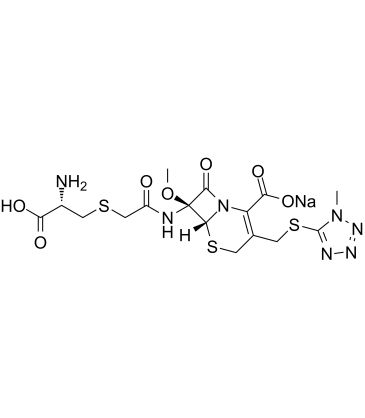
-
GC39537
Cefodizime
Cefodizime ist ein Cephalosporin-Antibiotikum der dritten Generation mit einem breiten antibakteriellen Wirkungsspektrum.
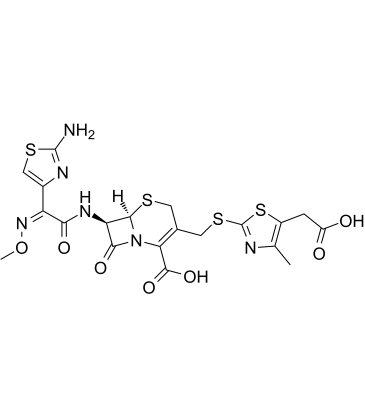
-
GC60104
Cefodizime sodium
Cefodizim-Natrium ist ein Cephalosporin-Antibiotikum der dritten Generation mit einem breiten antibakteriellen Wirkungsspektrum.
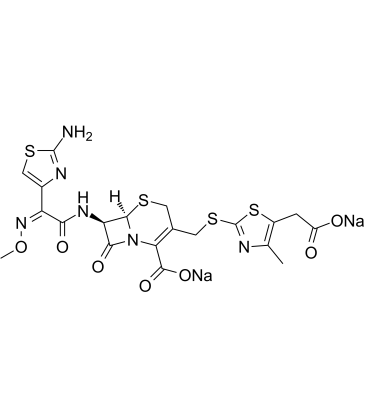
-
GC17813
Cefonicid (sodium salt)
Cefonicid (Natriumsalz) ist ein Breitspektrum-Cephalosporin-Antibiotikum, das die Bildung der Bakterienzellwand hemmt.
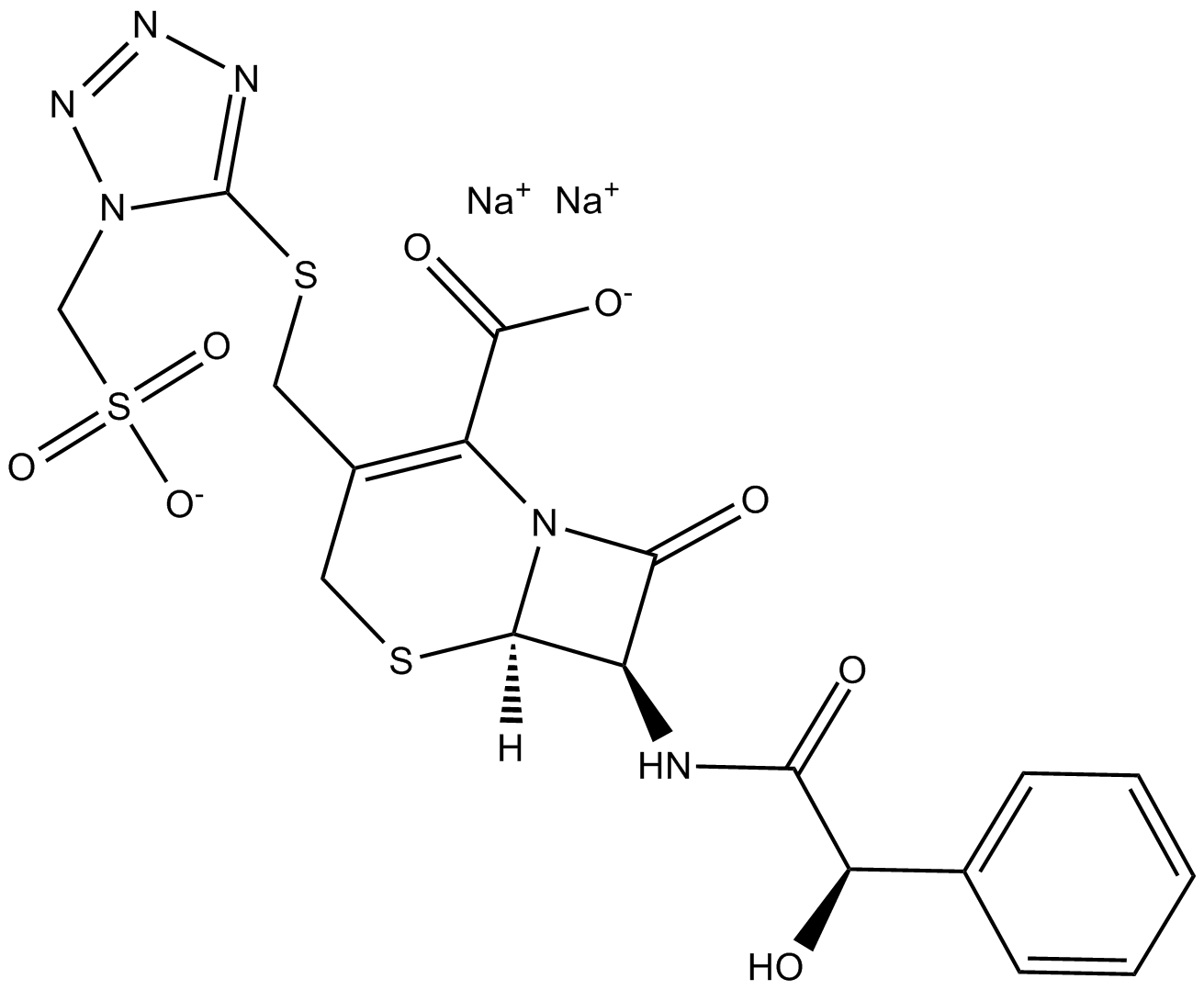
-
GC16501
Cefoperazone
Cefoperazon, ein halbsynthetisches Cephalosporin, hat ein breites Spektrum an antibakterieller AktivitÄt.
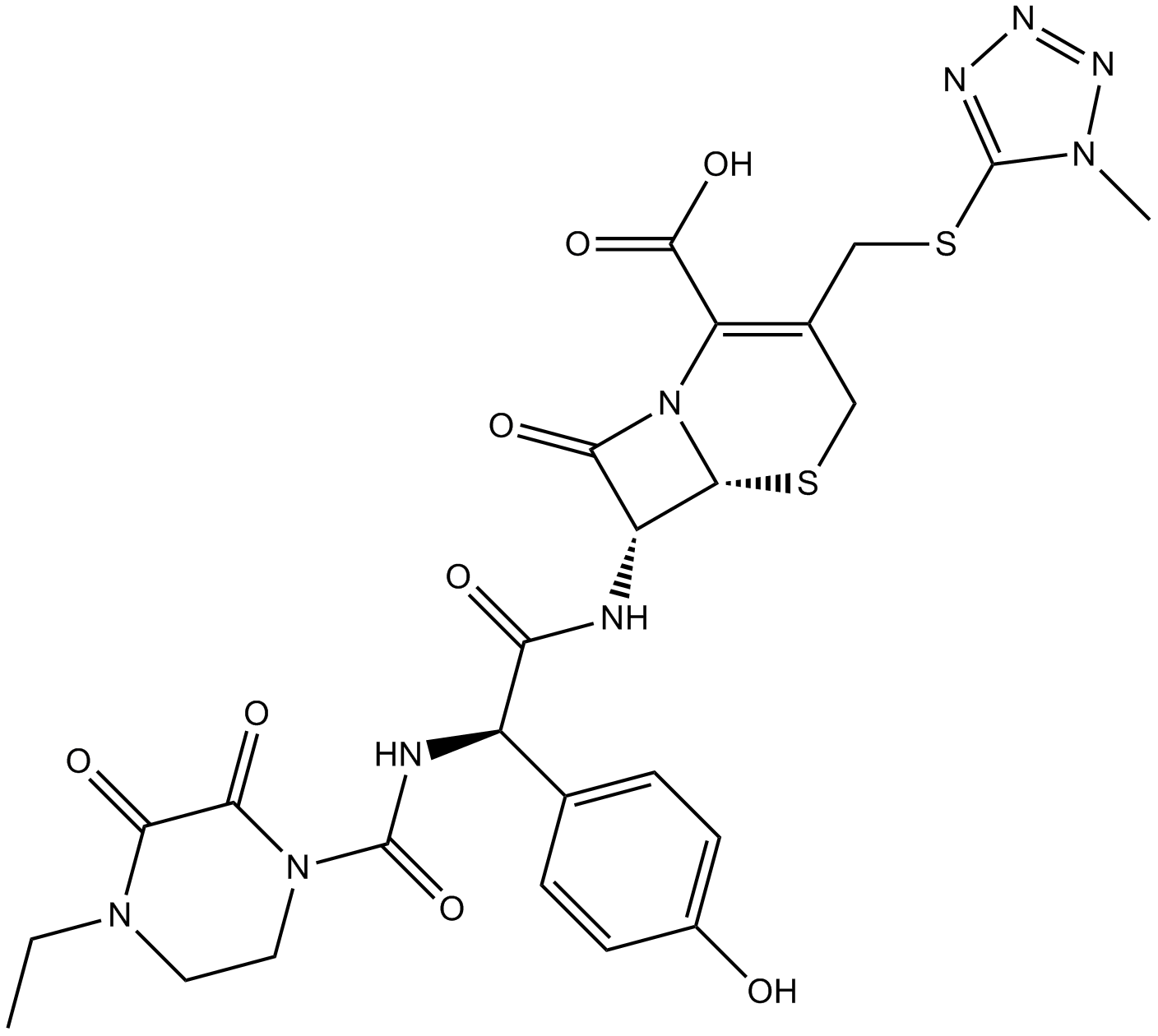
-
GC15412
Cefoperazone (sodium salt)
Cefoperazon (Natriumsalz) (CP 52640-2), ein halbsynthetisches Cephalosporin, hat ein breites Spektrum an antibakterieller Aktivität.
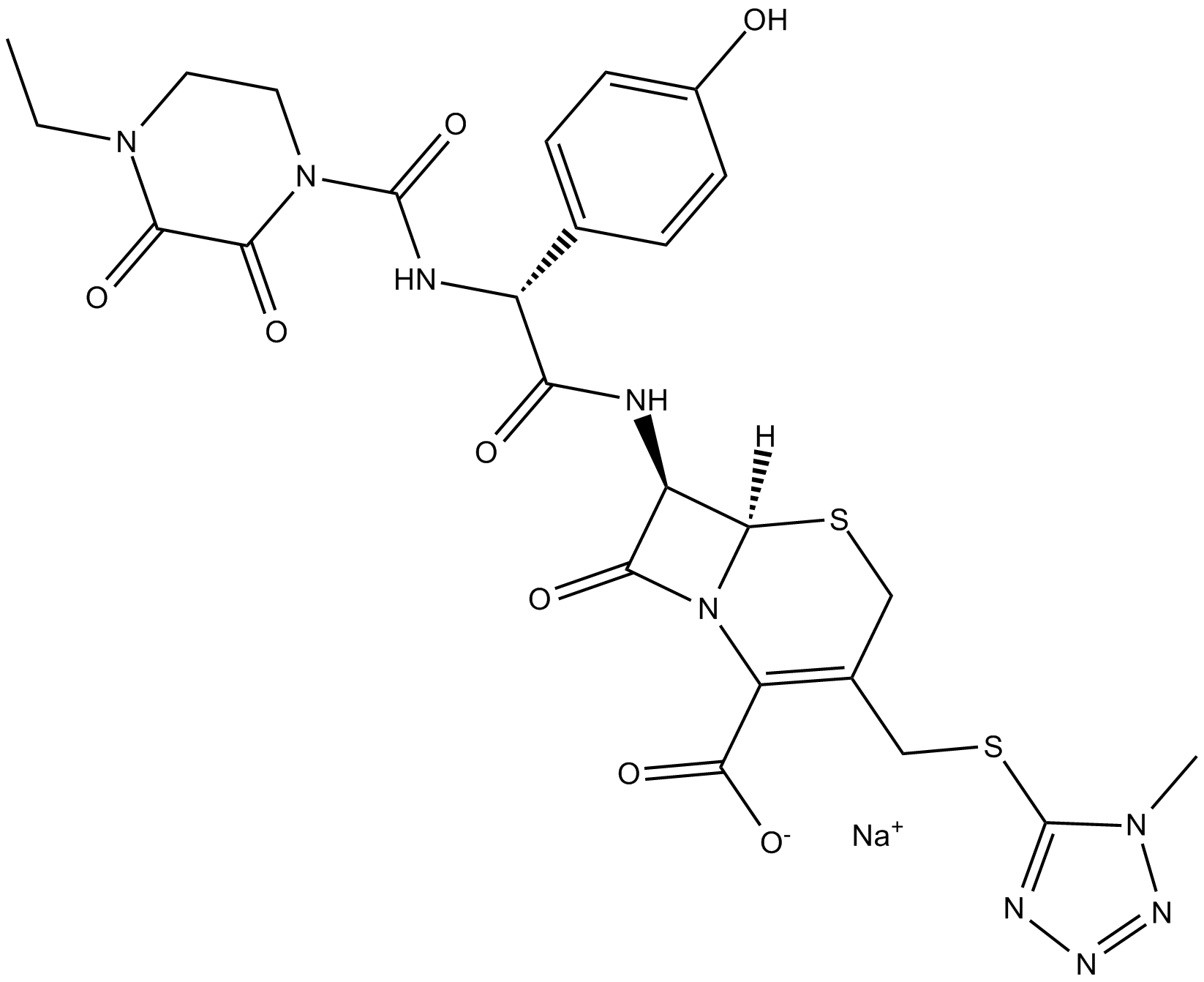
-
GC60684
Ceforanide
Ceforanid ist ein Cephalosporin der zweiten Generation, das intravenÖs oder intramuskulÄr verabreicht wird.
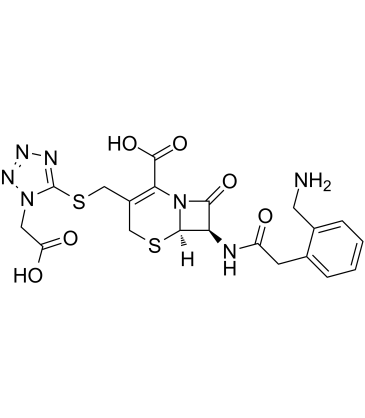
-
GC17728
Cefoselis
Cefoselis, die vierte Generation von Cephalosporin, ist ein β-Lactam-Antibiotikum.
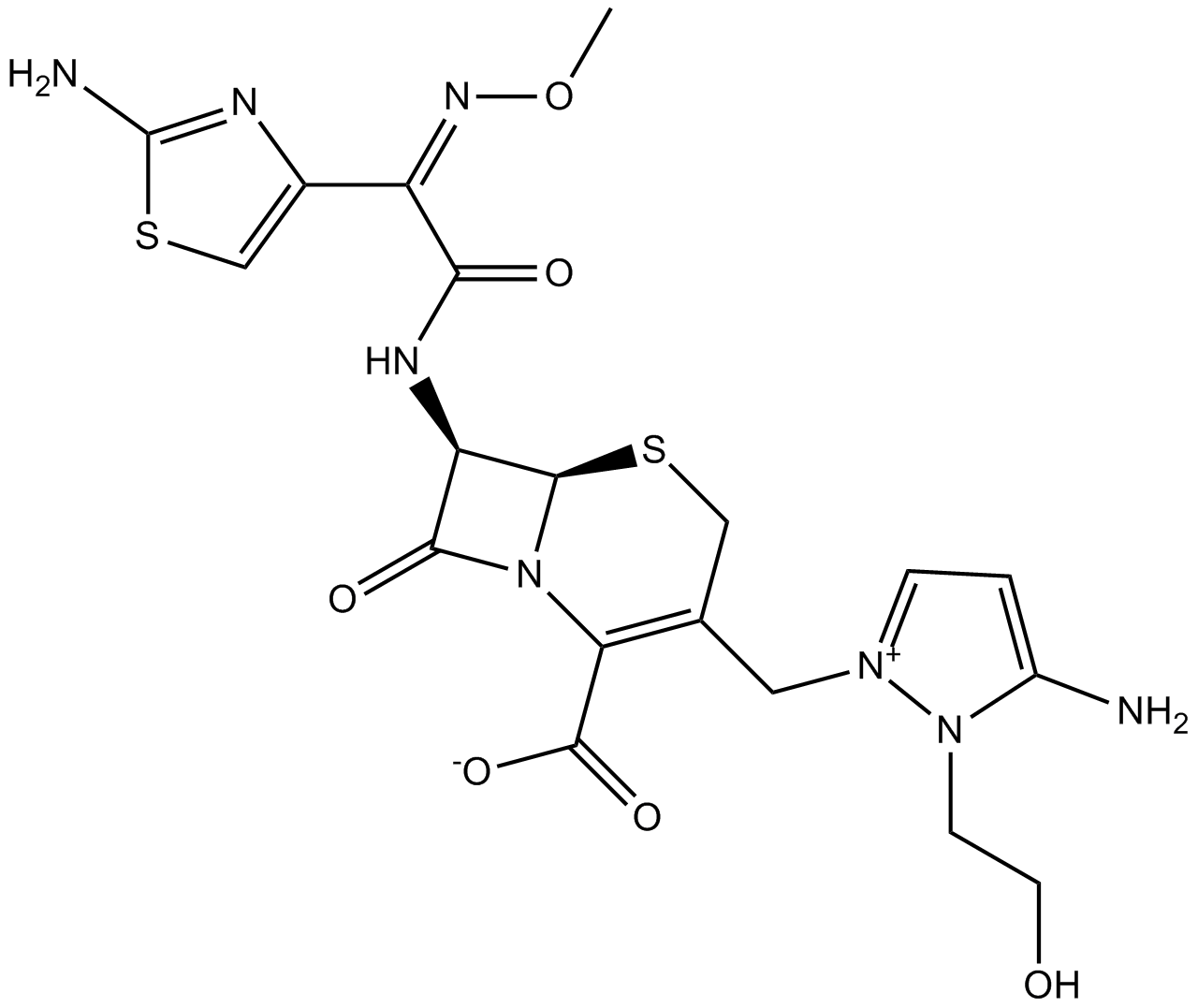
-
GC16076
Cefoselis hydrochloride
Cefoselis-Hydrochlorid, die vierte Generation von Cephalosporin, ist ein β-Lactam-Antibiotikum.
-
GC15398
Cefoselis Sulfate
Cefoselissulfat (FK-037), die vierte Generation von Cephalosporin, ist ein β-Lactam-Antibiotikum.
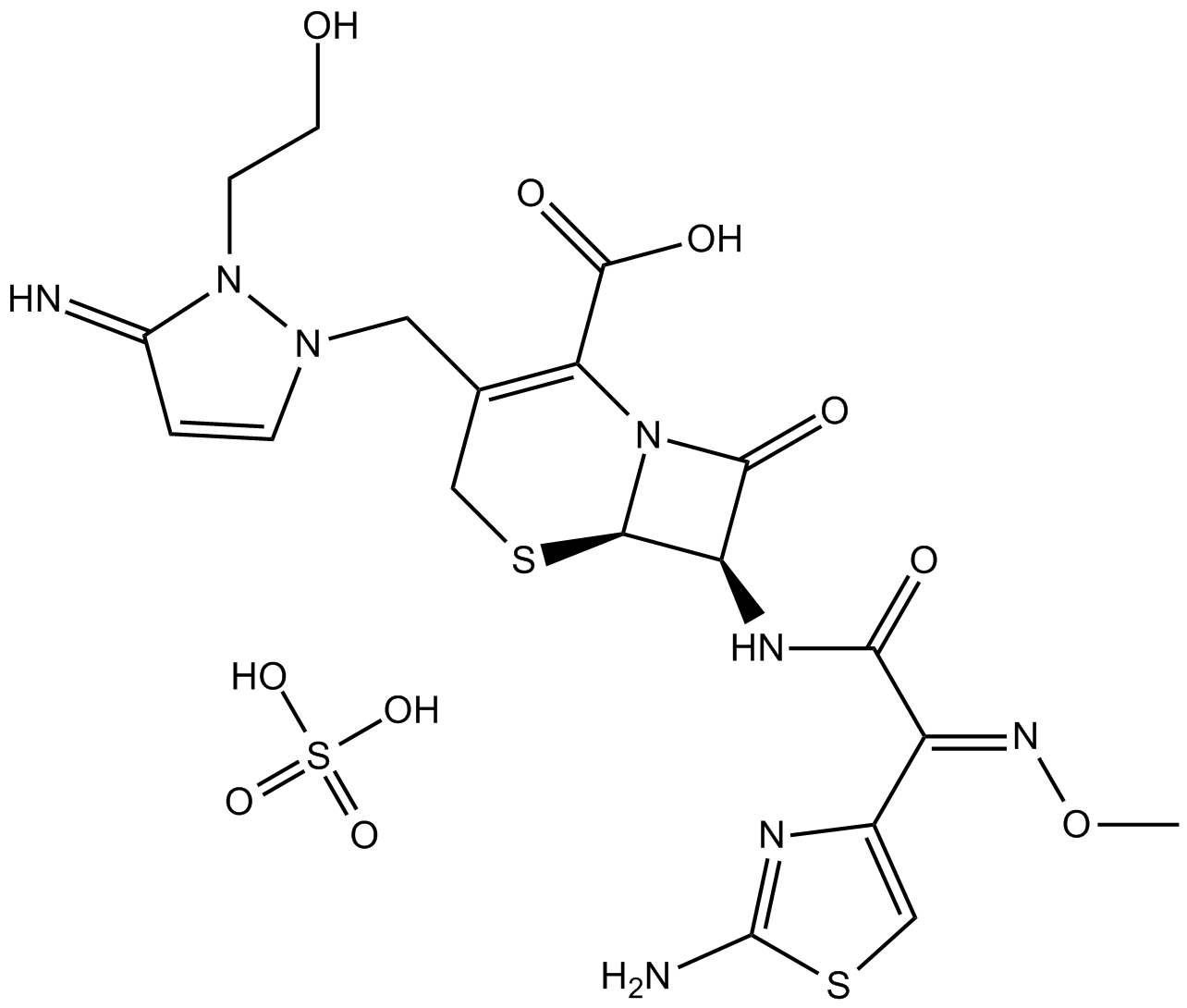
-
GC60685
Cefotaxime
Cefotaxim, ein β-Lactamase-stabiles Cephalosporin und ein Cephalosporin-Antibiotikum der dritten Generation, besitzt eine breite antibiotische AktivitÄt gegen zahlreiche grampositive und gramnegative Bakterien.
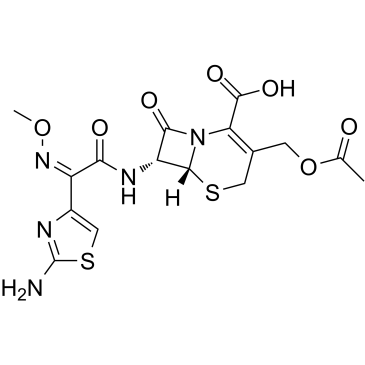
-
GC16544
Cefotaxime (sodium salt)
Cefotaxim (Cefotaxim)-Natrium, ein β-Lactamase-stabiles Cephalosporin und ein Cephalosporin-Antibiotikum der dritten Generation, besitzt eine breite antibiotische AktivitÄt gegen zahlreiche grampositive und gramnegative Bakterien.
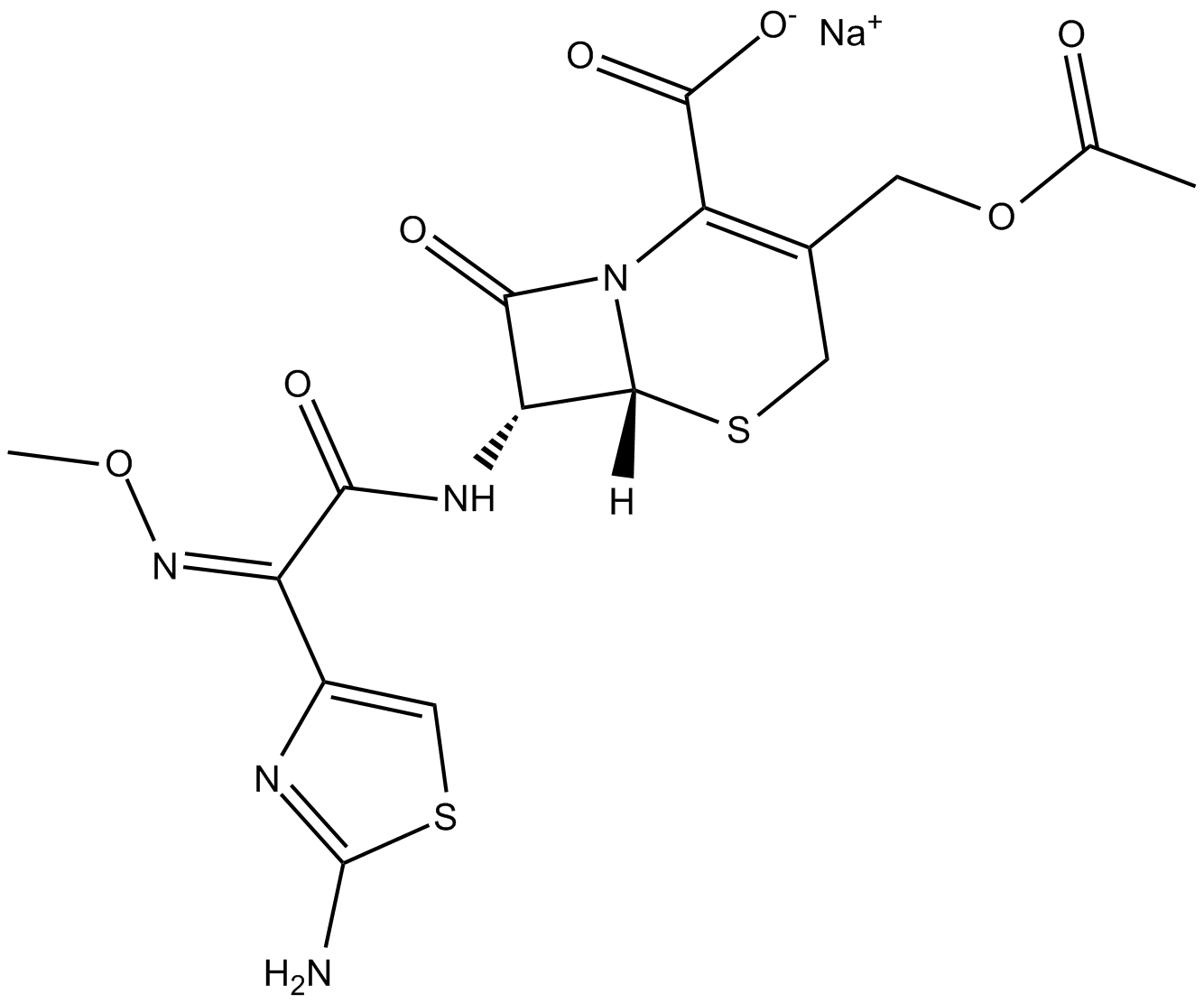
-
GC38032
Cefotetan
Cefotetan ist ein halbsynthetisches Cephamycin-Antibiotikum, das seine bakterizide Wirkung durch Hemmung der Zellwandsynthese ausÜbt.
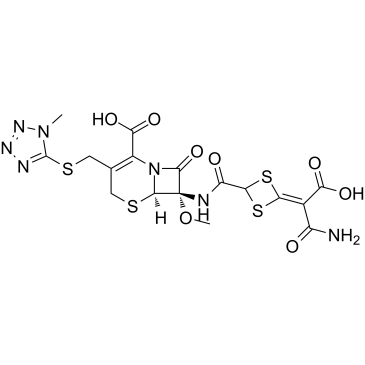
-
GC43223
Cefotetan (sodium salt)
Cefotetan (Natriumsalz) ist ein halbsynthetisches Cephamycin-Antibiotikum, das seine bakterizide Wirkung durch Hemmung der Zellwandsynthese entfaltet.
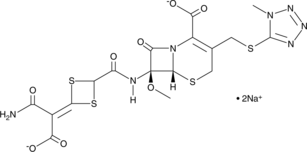
-
GC32212
Cefotiam hydrochloride (SCE-963 hydrochloride)
Cefotiam (SCE-963) Hydrochlorid ist ein parenterales Cephalosporin-Antibiotikum.
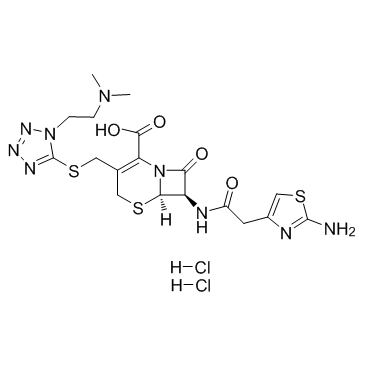
-
GC60686
Cefoxitin
Cefoxitin, ein β-Lactam-Antibiotikum, ist ein Breitspektrum-Cephalosporin der zweiten Generation.
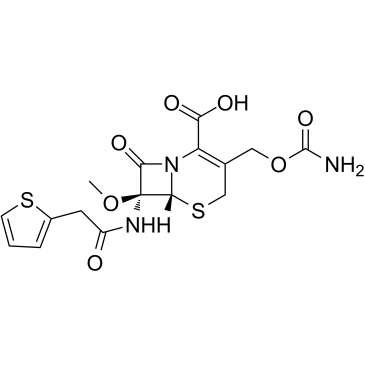
-
GC16446
Cefoxitin (sodium salt)
Cefoxitin (Natriumsalz) (MK-306) ist ein Cephamycin-Antibiotikum, oft eingruppiert mit den Cephalosporinen der zweiten Generation, wirkt durch Eingriff in die Zellwandsynthese, sein AktivitÄtsspektrum umfasst ein breites Spektrum gramnegativer und grampositiver Bakterien.
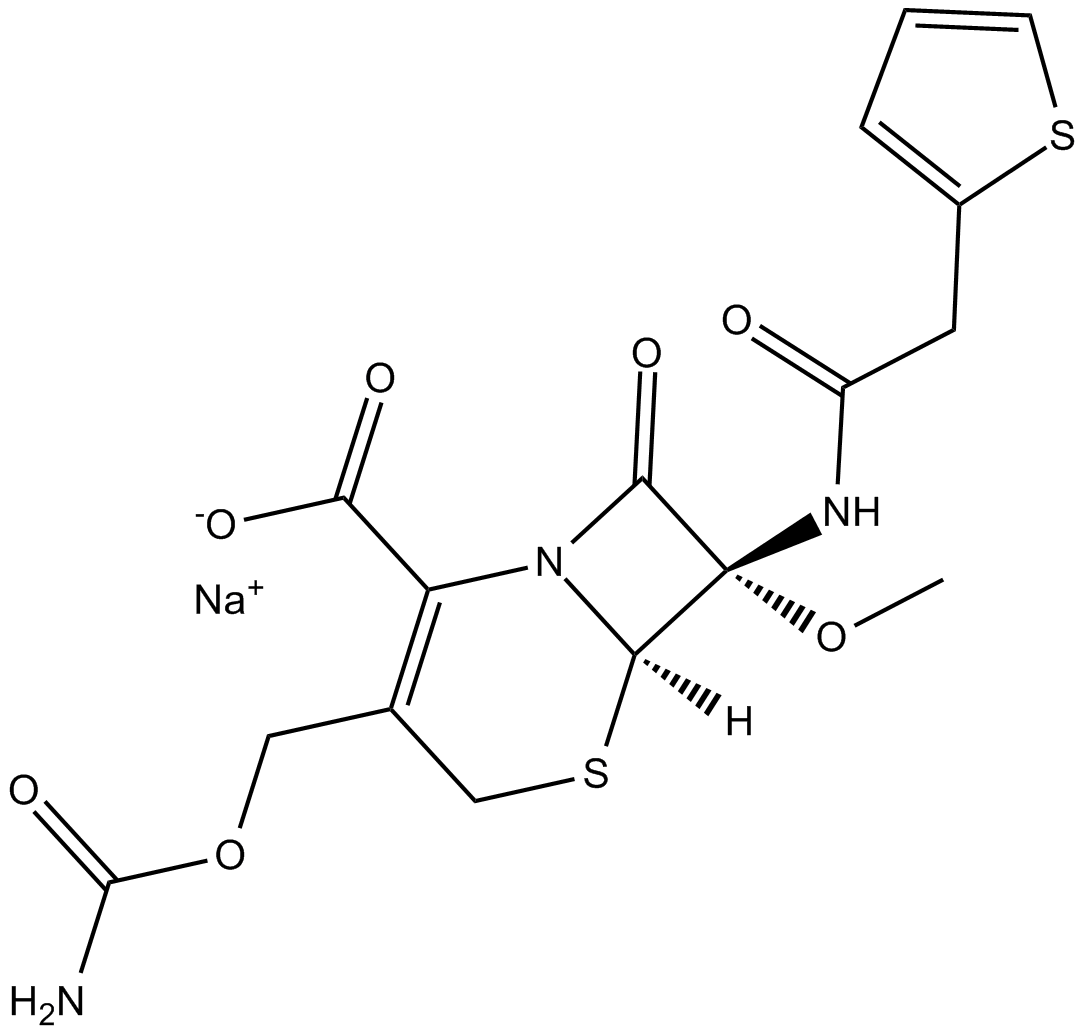
-
GC32236
Cefozopran (SCE-2787)
Cefozopran (SCE-2787) (SCE-2787) ist ein halbsynthetisches, parenterales Cephalosporin der vierten Generation.
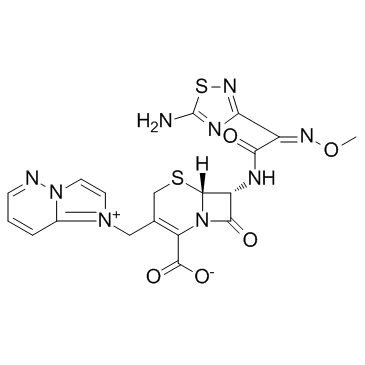
-
GC32139
Cefozopran hydrochloride (SCE-2787 hydrochloride)
Cefozopran (SCE-2787) Hydrochlorid ist ein halbsynthetisches, parenterales Cephalosporin der vierten Generation.
